Critical Analysis of Deepwater Horizon Oil Spill
VerifiedAdded on 2022/10/10
|17
|5200
|121
AI Summary
This report critically analyzes the Deepwater Horizon oil spill in the Gulf of Mexico from technical and non-technical perspectives. It evaluates the poor engineering designs, inherent risks, and extensive environmental, social and economic impact caused by the disaster.
Contribute Materials
Your contribution can guide someone’s learning journey. Share your
documents today.
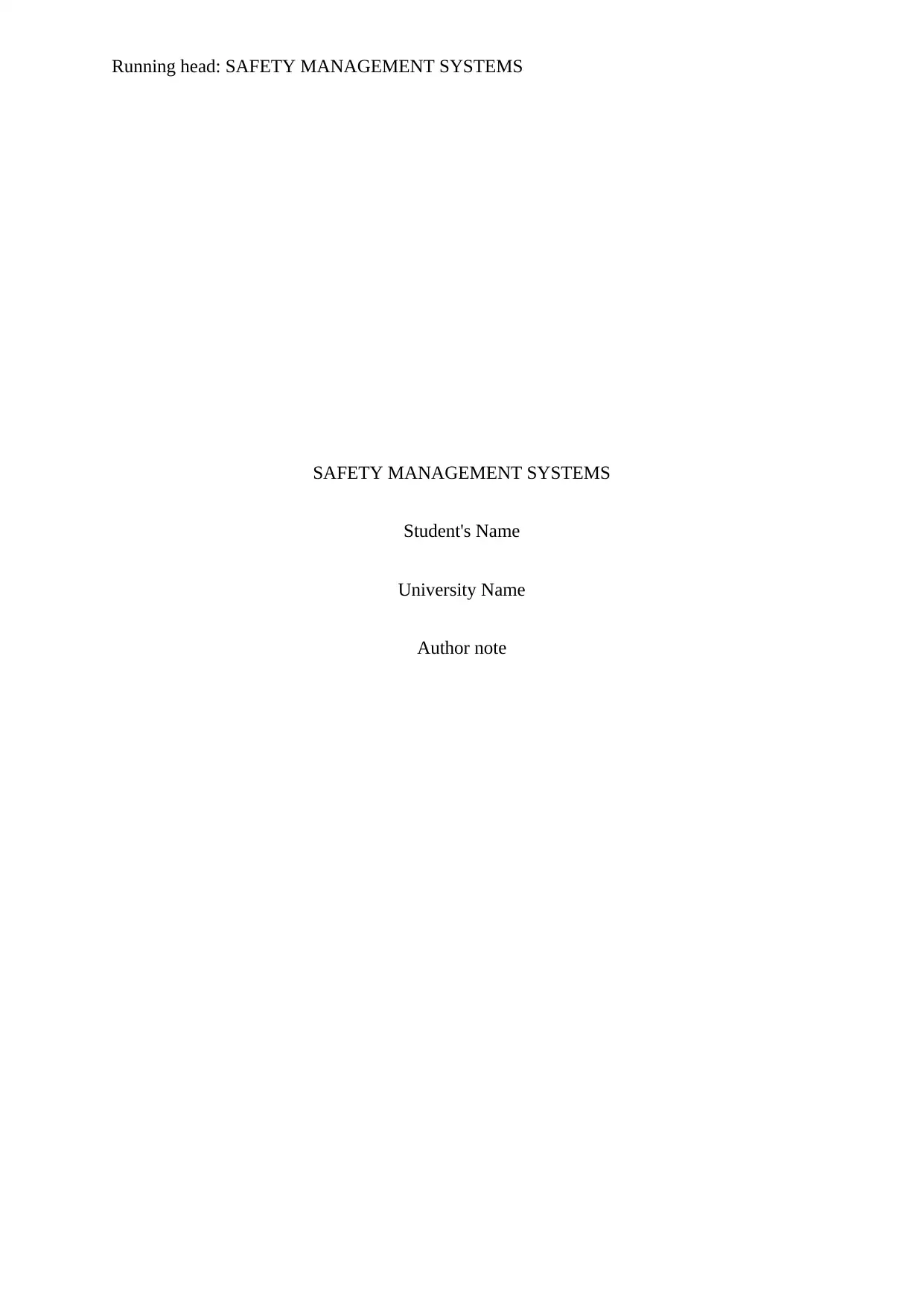
Running head: SAFETY MANAGEMENT SYSTEMS
SAFETY MANAGEMENT SYSTEMS
Student's Name
University Name
Author note
SAFETY MANAGEMENT SYSTEMS
Student's Name
University Name
Author note
Secure Best Marks with AI Grader
Need help grading? Try our AI Grader for instant feedback on your assignments.
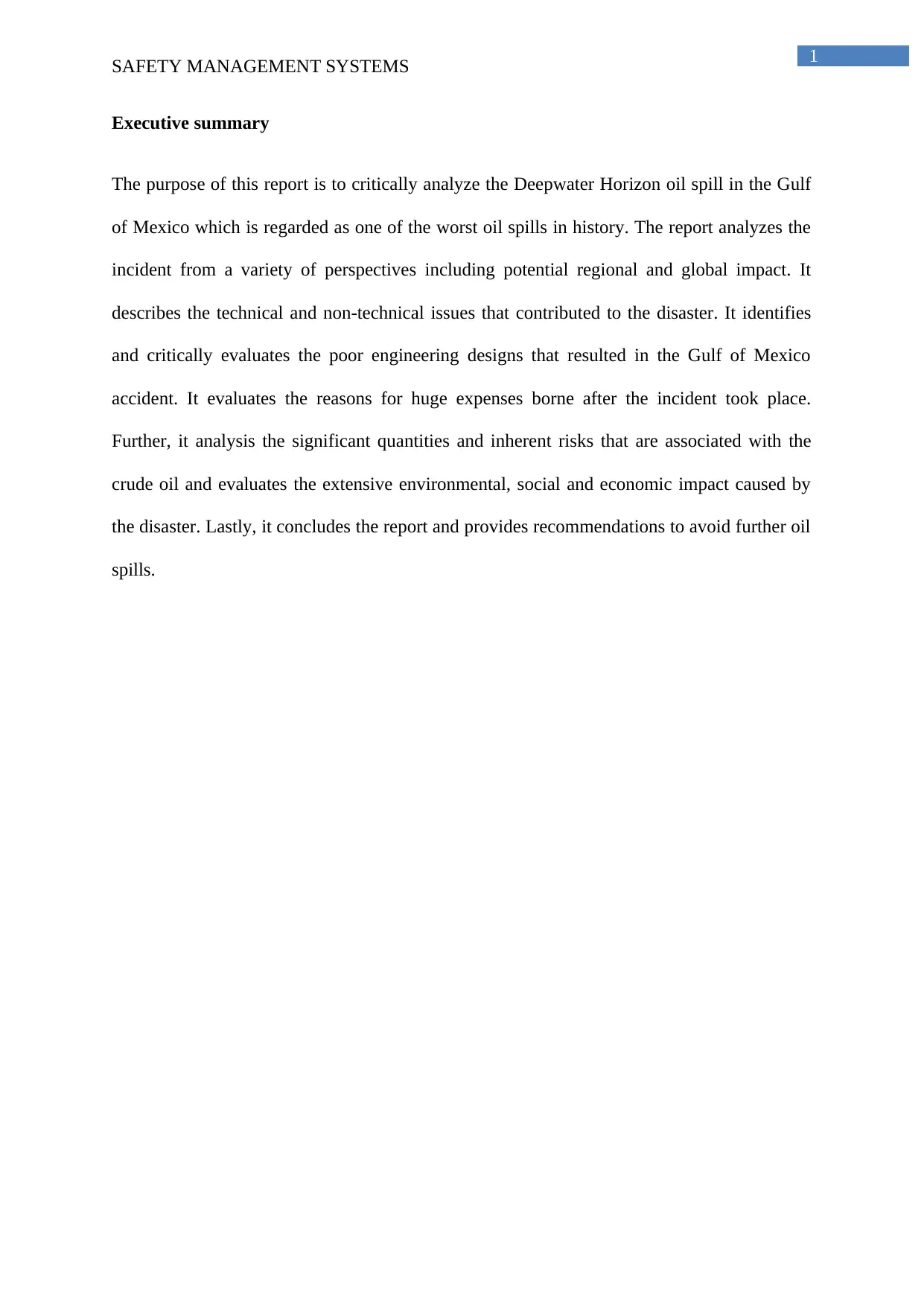
1
SAFETY MANAGEMENT SYSTEMS
Executive summary
The purpose of this report is to critically analyze the Deepwater Horizon oil spill in the Gulf
of Mexico which is regarded as one of the worst oil spills in history. The report analyzes the
incident from a variety of perspectives including potential regional and global impact. It
describes the technical and non-technical issues that contributed to the disaster. It identifies
and critically evaluates the poor engineering designs that resulted in the Gulf of Mexico
accident. It evaluates the reasons for huge expenses borne after the incident took place.
Further, it analysis the significant quantities and inherent risks that are associated with the
crude oil and evaluates the extensive environmental, social and economic impact caused by
the disaster. Lastly, it concludes the report and provides recommendations to avoid further oil
spills.
SAFETY MANAGEMENT SYSTEMS
Executive summary
The purpose of this report is to critically analyze the Deepwater Horizon oil spill in the Gulf
of Mexico which is regarded as one of the worst oil spills in history. The report analyzes the
incident from a variety of perspectives including potential regional and global impact. It
describes the technical and non-technical issues that contributed to the disaster. It identifies
and critically evaluates the poor engineering designs that resulted in the Gulf of Mexico
accident. It evaluates the reasons for huge expenses borne after the incident took place.
Further, it analysis the significant quantities and inherent risks that are associated with the
crude oil and evaluates the extensive environmental, social and economic impact caused by
the disaster. Lastly, it concludes the report and provides recommendations to avoid further oil
spills.
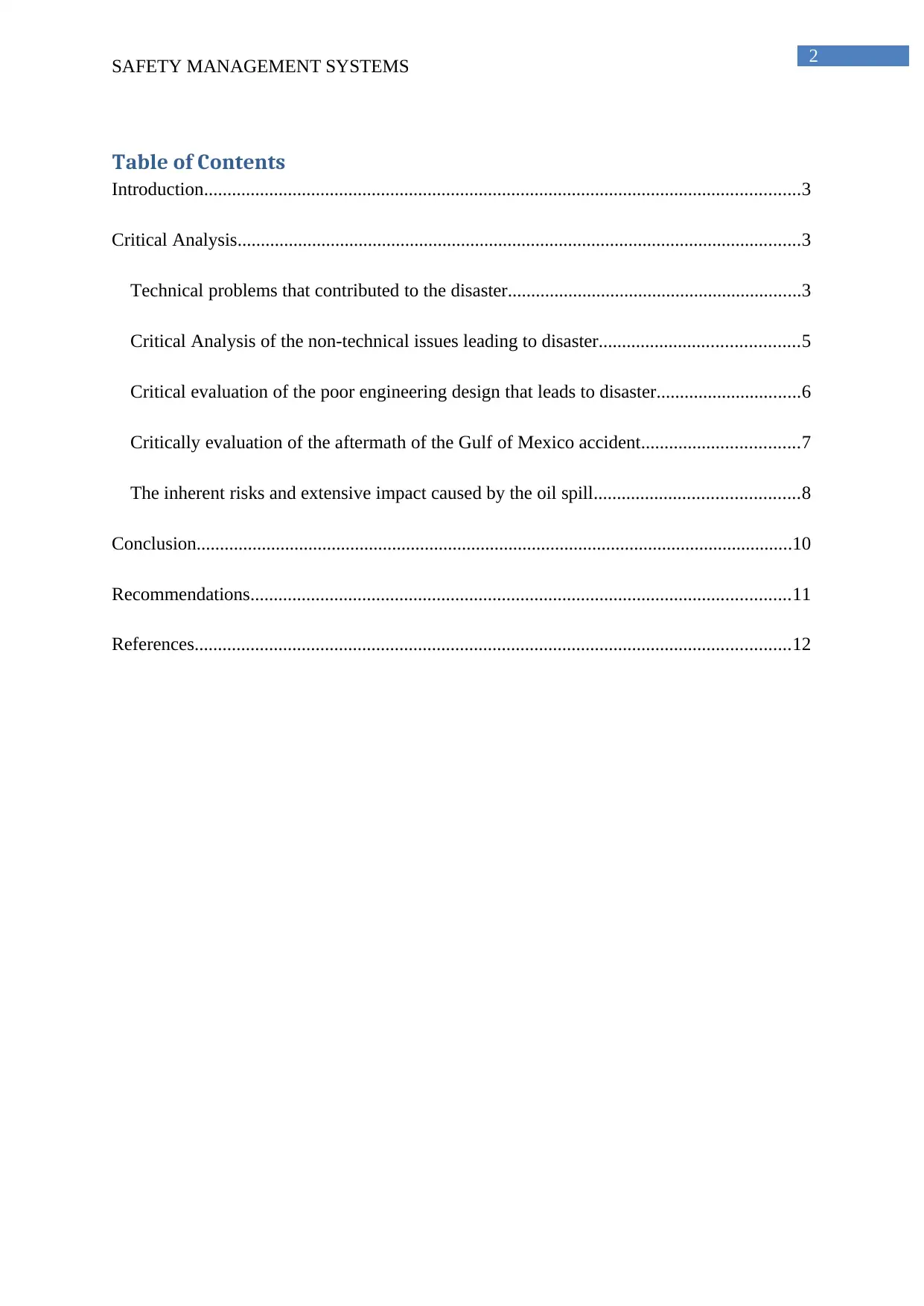
2
SAFETY MANAGEMENT SYSTEMS
Table of Contents
Introduction................................................................................................................................3
Critical Analysis.........................................................................................................................3
Technical problems that contributed to the disaster...............................................................3
Critical Analysis of the non-technical issues leading to disaster...........................................5
Critical evaluation of the poor engineering design that leads to disaster...............................6
Critically evaluation of the aftermath of the Gulf of Mexico accident..................................7
The inherent risks and extensive impact caused by the oil spill............................................8
Conclusion................................................................................................................................10
Recommendations....................................................................................................................11
References................................................................................................................................12
SAFETY MANAGEMENT SYSTEMS
Table of Contents
Introduction................................................................................................................................3
Critical Analysis.........................................................................................................................3
Technical problems that contributed to the disaster...............................................................3
Critical Analysis of the non-technical issues leading to disaster...........................................5
Critical evaluation of the poor engineering design that leads to disaster...............................6
Critically evaluation of the aftermath of the Gulf of Mexico accident..................................7
The inherent risks and extensive impact caused by the oil spill............................................8
Conclusion................................................................................................................................10
Recommendations....................................................................................................................11
References................................................................................................................................12
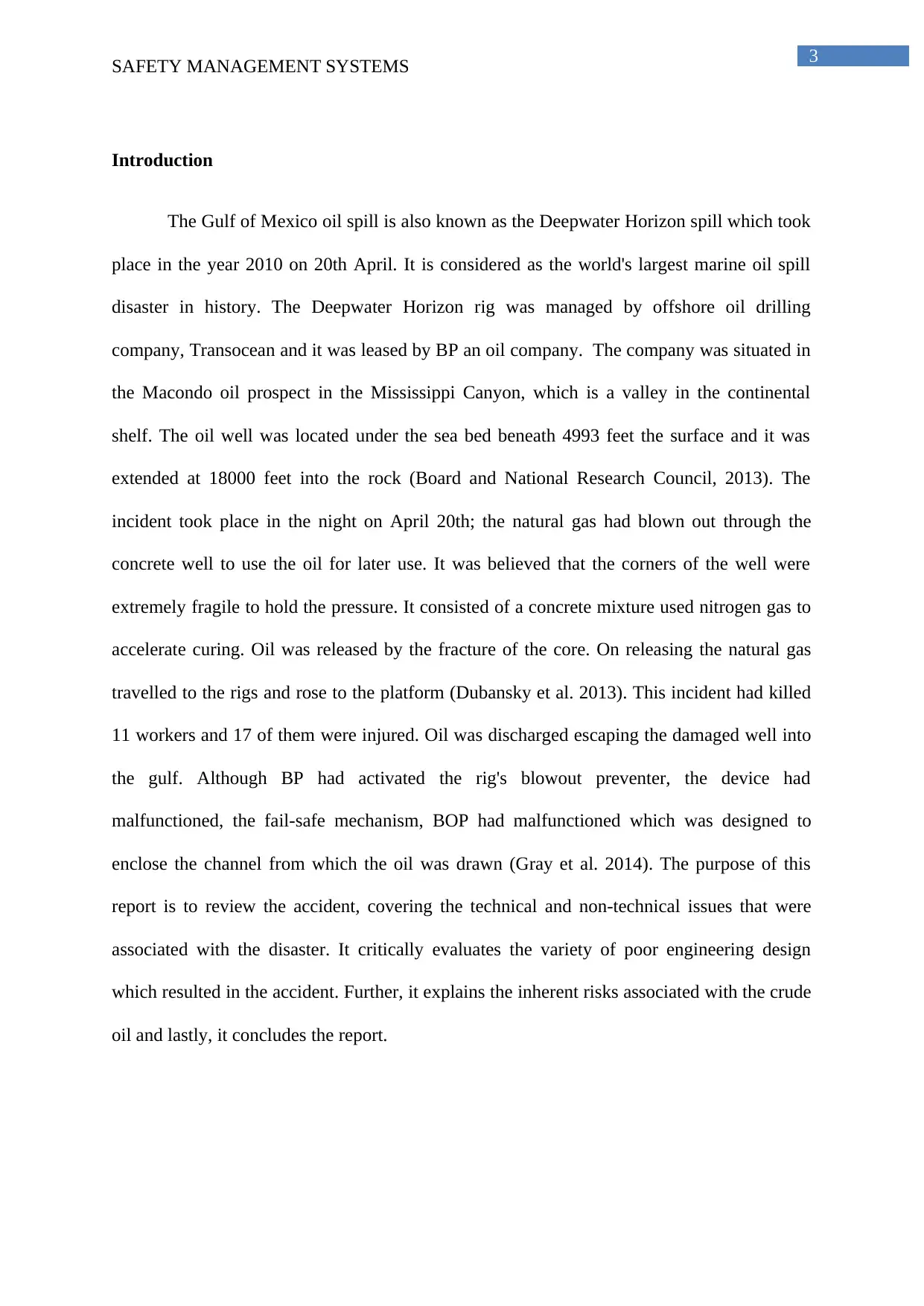
3
SAFETY MANAGEMENT SYSTEMS
Introduction
The Gulf of Mexico oil spill is also known as the Deepwater Horizon spill which took
place in the year 2010 on 20th April. It is considered as the world's largest marine oil spill
disaster in history. The Deepwater Horizon rig was managed by offshore oil drilling
company, Transocean and it was leased by BP an oil company. The company was situated in
the Macondo oil prospect in the Mississippi Canyon, which is a valley in the continental
shelf. The oil well was located under the sea bed beneath 4993 feet the surface and it was
extended at 18000 feet into the rock (Board and National Research Council, 2013). The
incident took place in the night on April 20th; the natural gas had blown out through the
concrete well to use the oil for later use. It was believed that the corners of the well were
extremely fragile to hold the pressure. It consisted of a concrete mixture used nitrogen gas to
accelerate curing. Oil was released by the fracture of the core. On releasing the natural gas
travelled to the rigs and rose to the platform (Dubansky et al. 2013). This incident had killed
11 workers and 17 of them were injured. Oil was discharged escaping the damaged well into
the gulf. Although BP had activated the rig's blowout preventer, the device had
malfunctioned, the fail-safe mechanism, BOP had malfunctioned which was designed to
enclose the channel from which the oil was drawn (Gray et al. 2014). The purpose of this
report is to review the accident, covering the technical and non-technical issues that were
associated with the disaster. It critically evaluates the variety of poor engineering design
which resulted in the accident. Further, it explains the inherent risks associated with the crude
oil and lastly, it concludes the report.
SAFETY MANAGEMENT SYSTEMS
Introduction
The Gulf of Mexico oil spill is also known as the Deepwater Horizon spill which took
place in the year 2010 on 20th April. It is considered as the world's largest marine oil spill
disaster in history. The Deepwater Horizon rig was managed by offshore oil drilling
company, Transocean and it was leased by BP an oil company. The company was situated in
the Macondo oil prospect in the Mississippi Canyon, which is a valley in the continental
shelf. The oil well was located under the sea bed beneath 4993 feet the surface and it was
extended at 18000 feet into the rock (Board and National Research Council, 2013). The
incident took place in the night on April 20th; the natural gas had blown out through the
concrete well to use the oil for later use. It was believed that the corners of the well were
extremely fragile to hold the pressure. It consisted of a concrete mixture used nitrogen gas to
accelerate curing. Oil was released by the fracture of the core. On releasing the natural gas
travelled to the rigs and rose to the platform (Dubansky et al. 2013). This incident had killed
11 workers and 17 of them were injured. Oil was discharged escaping the damaged well into
the gulf. Although BP had activated the rig's blowout preventer, the device had
malfunctioned, the fail-safe mechanism, BOP had malfunctioned which was designed to
enclose the channel from which the oil was drawn (Gray et al. 2014). The purpose of this
report is to review the accident, covering the technical and non-technical issues that were
associated with the disaster. It critically evaluates the variety of poor engineering design
which resulted in the accident. Further, it explains the inherent risks associated with the crude
oil and lastly, it concludes the report.
Secure Best Marks with AI Grader
Need help grading? Try our AI Grader for instant feedback on your assignments.
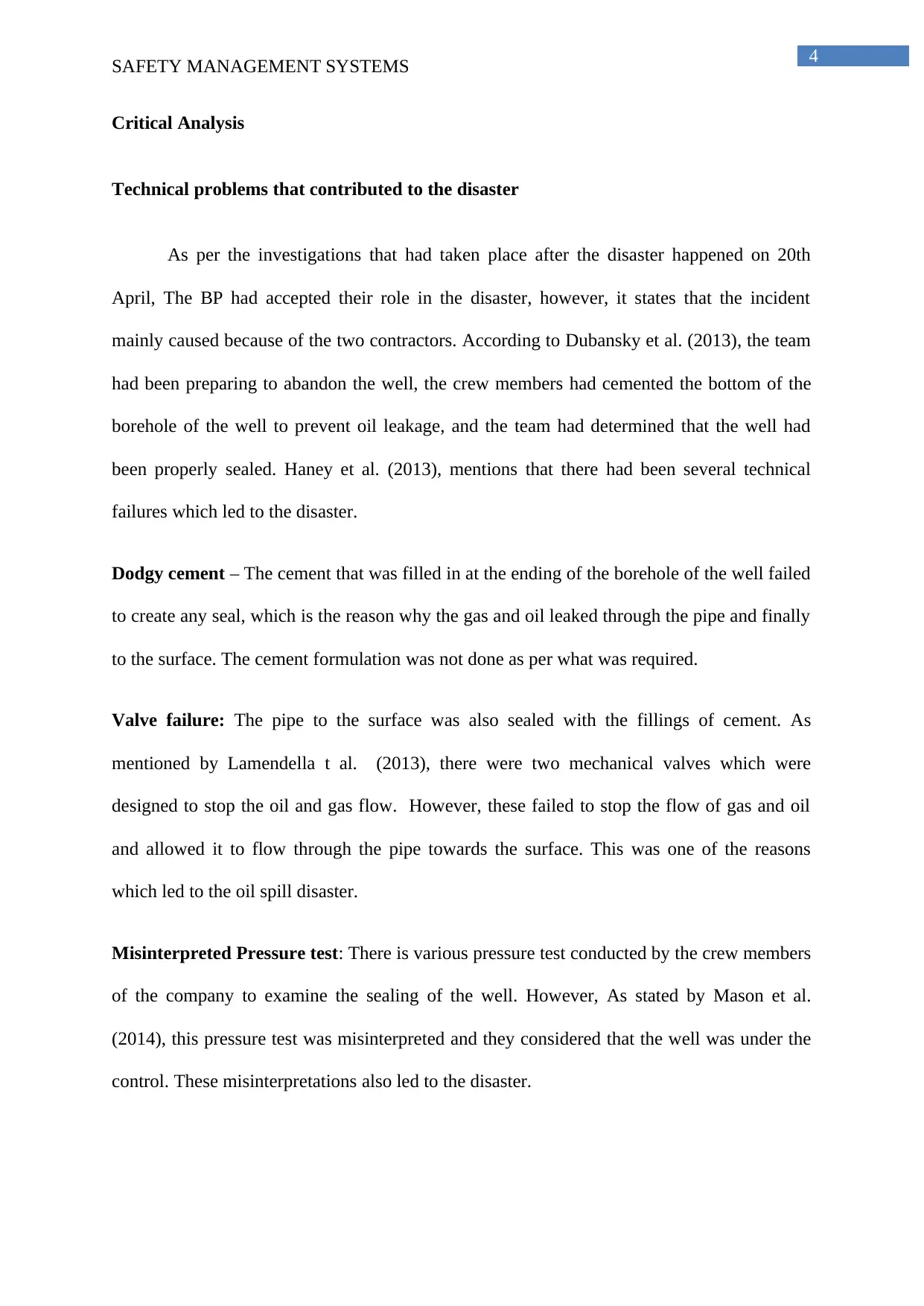
4
SAFETY MANAGEMENT SYSTEMS
Critical Analysis
Technical problems that contributed to the disaster
As per the investigations that had taken place after the disaster happened on 20th
April, The BP had accepted their role in the disaster, however, it states that the incident
mainly caused because of the two contractors. According to Dubansky et al. (2013), the team
had been preparing to abandon the well, the crew members had cemented the bottom of the
borehole of the well to prevent oil leakage, and the team had determined that the well had
been properly sealed. Haney et al. (2013), mentions that there had been several technical
failures which led to the disaster.
Dodgy cement – The cement that was filled in at the ending of the borehole of the well failed
to create any seal, which is the reason why the gas and oil leaked through the pipe and finally
to the surface. The cement formulation was not done as per what was required.
Valve failure: The pipe to the surface was also sealed with the fillings of cement. As
mentioned by Lamendella t al. (2013), there were two mechanical valves which were
designed to stop the oil and gas flow. However, these failed to stop the flow of gas and oil
and allowed it to flow through the pipe towards the surface. This was one of the reasons
which led to the oil spill disaster.
Misinterpreted Pressure test: There is various pressure test conducted by the crew members
of the company to examine the sealing of the well. However, As stated by Mason et al.
(2014), this pressure test was misinterpreted and they considered that the well was under the
control. These misinterpretations also led to the disaster.
SAFETY MANAGEMENT SYSTEMS
Critical Analysis
Technical problems that contributed to the disaster
As per the investigations that had taken place after the disaster happened on 20th
April, The BP had accepted their role in the disaster, however, it states that the incident
mainly caused because of the two contractors. According to Dubansky et al. (2013), the team
had been preparing to abandon the well, the crew members had cemented the bottom of the
borehole of the well to prevent oil leakage, and the team had determined that the well had
been properly sealed. Haney et al. (2013), mentions that there had been several technical
failures which led to the disaster.
Dodgy cement – The cement that was filled in at the ending of the borehole of the well failed
to create any seal, which is the reason why the gas and oil leaked through the pipe and finally
to the surface. The cement formulation was not done as per what was required.
Valve failure: The pipe to the surface was also sealed with the fillings of cement. As
mentioned by Lamendella t al. (2013), there were two mechanical valves which were
designed to stop the oil and gas flow. However, these failed to stop the flow of gas and oil
and allowed it to flow through the pipe towards the surface. This was one of the reasons
which led to the oil spill disaster.
Misinterpreted Pressure test: There is various pressure test conducted by the crew members
of the company to examine the sealing of the well. However, As stated by Mason et al.
(2014), this pressure test was misinterpreted and they considered that the well was under the
control. These misinterpretations also led to the disaster.
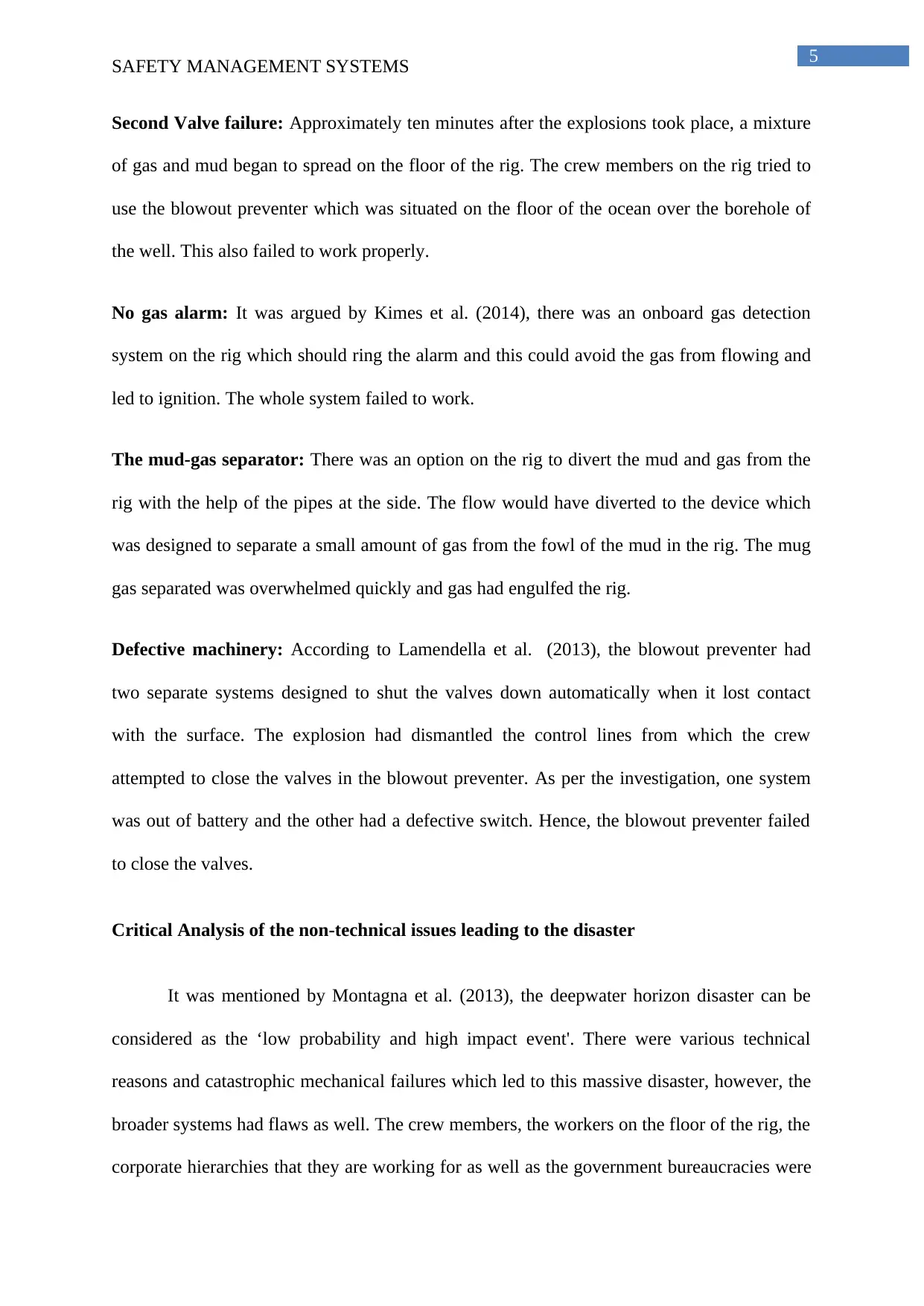
5
SAFETY MANAGEMENT SYSTEMS
Second Valve failure: Approximately ten minutes after the explosions took place, a mixture
of gas and mud began to spread on the floor of the rig. The crew members on the rig tried to
use the blowout preventer which was situated on the floor of the ocean over the borehole of
the well. This also failed to work properly.
No gas alarm: It was argued by Kimes et al. (2014), there was an onboard gas detection
system on the rig which should ring the alarm and this could avoid the gas from flowing and
led to ignition. The whole system failed to work.
The mud-gas separator: There was an option on the rig to divert the mud and gas from the
rig with the help of the pipes at the side. The flow would have diverted to the device which
was designed to separate a small amount of gas from the fowl of the mud in the rig. The mug
gas separated was overwhelmed quickly and gas had engulfed the rig.
Defective machinery: According to Lamendella et al. (2013), the blowout preventer had
two separate systems designed to shut the valves down automatically when it lost contact
with the surface. The explosion had dismantled the control lines from which the crew
attempted to close the valves in the blowout preventer. As per the investigation, one system
was out of battery and the other had a defective switch. Hence, the blowout preventer failed
to close the valves.
Critical Analysis of the non-technical issues leading to the disaster
It was mentioned by Montagna et al. (2013), the deepwater horizon disaster can be
considered as the ‘low probability and high impact event'. There were various technical
reasons and catastrophic mechanical failures which led to this massive disaster, however, the
broader systems had flaws as well. The crew members, the workers on the floor of the rig, the
corporate hierarchies that they are working for as well as the government bureaucracies were
SAFETY MANAGEMENT SYSTEMS
Second Valve failure: Approximately ten minutes after the explosions took place, a mixture
of gas and mud began to spread on the floor of the rig. The crew members on the rig tried to
use the blowout preventer which was situated on the floor of the ocean over the borehole of
the well. This also failed to work properly.
No gas alarm: It was argued by Kimes et al. (2014), there was an onboard gas detection
system on the rig which should ring the alarm and this could avoid the gas from flowing and
led to ignition. The whole system failed to work.
The mud-gas separator: There was an option on the rig to divert the mud and gas from the
rig with the help of the pipes at the side. The flow would have diverted to the device which
was designed to separate a small amount of gas from the fowl of the mud in the rig. The mug
gas separated was overwhelmed quickly and gas had engulfed the rig.
Defective machinery: According to Lamendella et al. (2013), the blowout preventer had
two separate systems designed to shut the valves down automatically when it lost contact
with the surface. The explosion had dismantled the control lines from which the crew
attempted to close the valves in the blowout preventer. As per the investigation, one system
was out of battery and the other had a defective switch. Hence, the blowout preventer failed
to close the valves.
Critical Analysis of the non-technical issues leading to the disaster
It was mentioned by Montagna et al. (2013), the deepwater horizon disaster can be
considered as the ‘low probability and high impact event'. There were various technical
reasons and catastrophic mechanical failures which led to this massive disaster, however, the
broader systems had flaws as well. The crew members, the workers on the floor of the rig, the
corporate hierarchies that they are working for as well as the government bureaucracies were
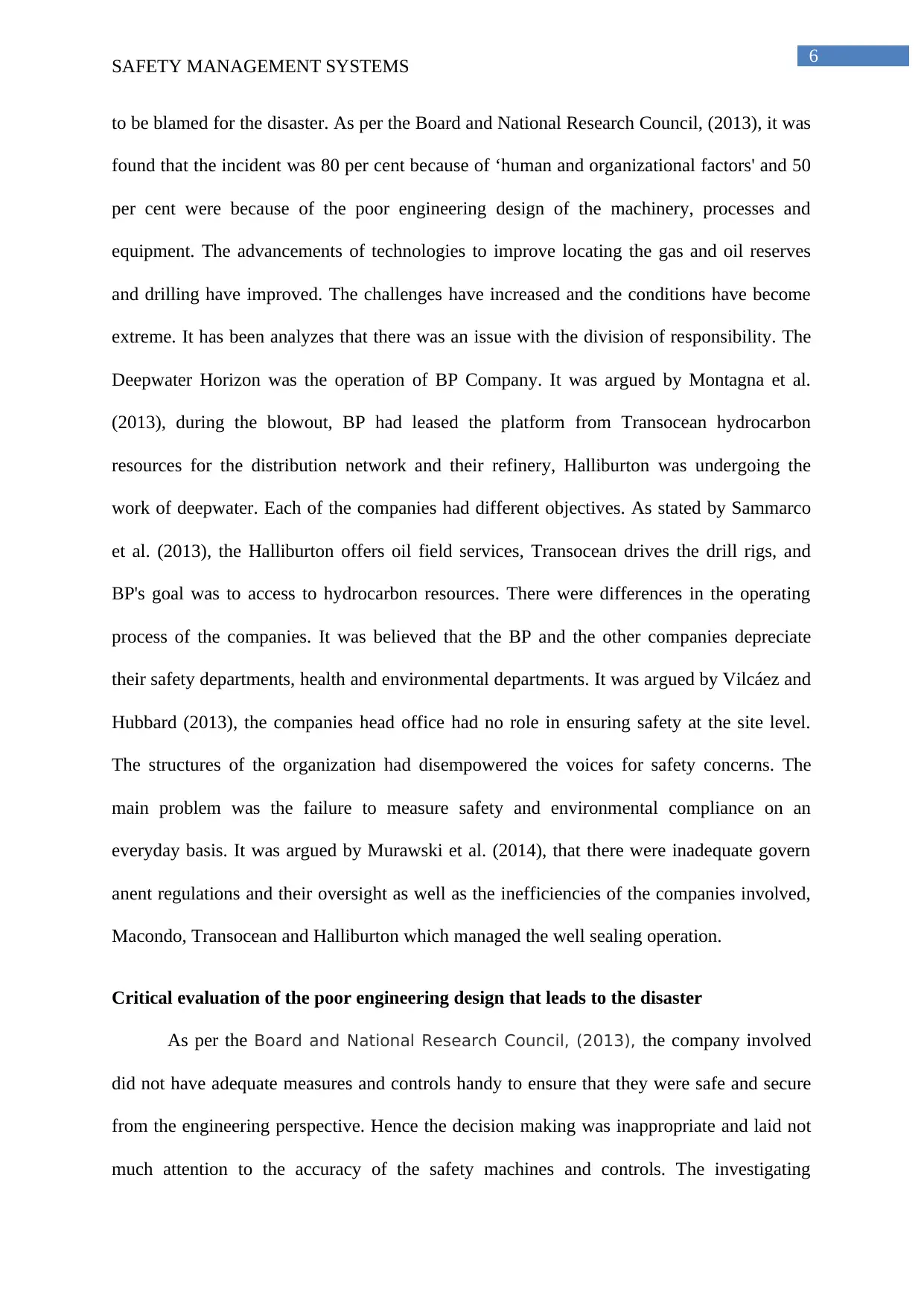
6
SAFETY MANAGEMENT SYSTEMS
to be blamed for the disaster. As per the Board and National Research Council, (2013), it was
found that the incident was 80 per cent because of ‘human and organizational factors' and 50
per cent were because of the poor engineering design of the machinery, processes and
equipment. The advancements of technologies to improve locating the gas and oil reserves
and drilling have improved. The challenges have increased and the conditions have become
extreme. It has been analyzes that there was an issue with the division of responsibility. The
Deepwater Horizon was the operation of BP Company. It was argued by Montagna et al.
(2013), during the blowout, BP had leased the platform from Transocean hydrocarbon
resources for the distribution network and their refinery, Halliburton was undergoing the
work of deepwater. Each of the companies had different objectives. As stated by Sammarco
et al. (2013), the Halliburton offers oil field services, Transocean drives the drill rigs, and
BP's goal was to access to hydrocarbon resources. There were differences in the operating
process of the companies. It was believed that the BP and the other companies depreciate
their safety departments, health and environmental departments. It was argued by Vilcáez and
Hubbard (2013), the companies head office had no role in ensuring safety at the site level.
The structures of the organization had disempowered the voices for safety concerns. The
main problem was the failure to measure safety and environmental compliance on an
everyday basis. It was argued by Murawski et al. (2014), that there were inadequate govern
anent regulations and their oversight as well as the inefficiencies of the companies involved,
Macondo, Transocean and Halliburton which managed the well sealing operation.
Critical evaluation of the poor engineering design that leads to the disaster
As per the Board and National Research Council, (2013), the company involved
did not have adequate measures and controls handy to ensure that they were safe and secure
from the engineering perspective. Hence the decision making was inappropriate and laid not
much attention to the accuracy of the safety machines and controls. The investigating
SAFETY MANAGEMENT SYSTEMS
to be blamed for the disaster. As per the Board and National Research Council, (2013), it was
found that the incident was 80 per cent because of ‘human and organizational factors' and 50
per cent were because of the poor engineering design of the machinery, processes and
equipment. The advancements of technologies to improve locating the gas and oil reserves
and drilling have improved. The challenges have increased and the conditions have become
extreme. It has been analyzes that there was an issue with the division of responsibility. The
Deepwater Horizon was the operation of BP Company. It was argued by Montagna et al.
(2013), during the blowout, BP had leased the platform from Transocean hydrocarbon
resources for the distribution network and their refinery, Halliburton was undergoing the
work of deepwater. Each of the companies had different objectives. As stated by Sammarco
et al. (2013), the Halliburton offers oil field services, Transocean drives the drill rigs, and
BP's goal was to access to hydrocarbon resources. There were differences in the operating
process of the companies. It was believed that the BP and the other companies depreciate
their safety departments, health and environmental departments. It was argued by Vilcáez and
Hubbard (2013), the companies head office had no role in ensuring safety at the site level.
The structures of the organization had disempowered the voices for safety concerns. The
main problem was the failure to measure safety and environmental compliance on an
everyday basis. It was argued by Murawski et al. (2014), that there were inadequate govern
anent regulations and their oversight as well as the inefficiencies of the companies involved,
Macondo, Transocean and Halliburton which managed the well sealing operation.
Critical evaluation of the poor engineering design that leads to the disaster
As per the Board and National Research Council, (2013), the company involved
did not have adequate measures and controls handy to ensure that they were safe and secure
from the engineering perspective. Hence the decision making was inappropriate and laid not
much attention to the accuracy of the safety machines and controls. The investigating
Paraphrase This Document
Need a fresh take? Get an instant paraphrase of this document with our AI Paraphraser
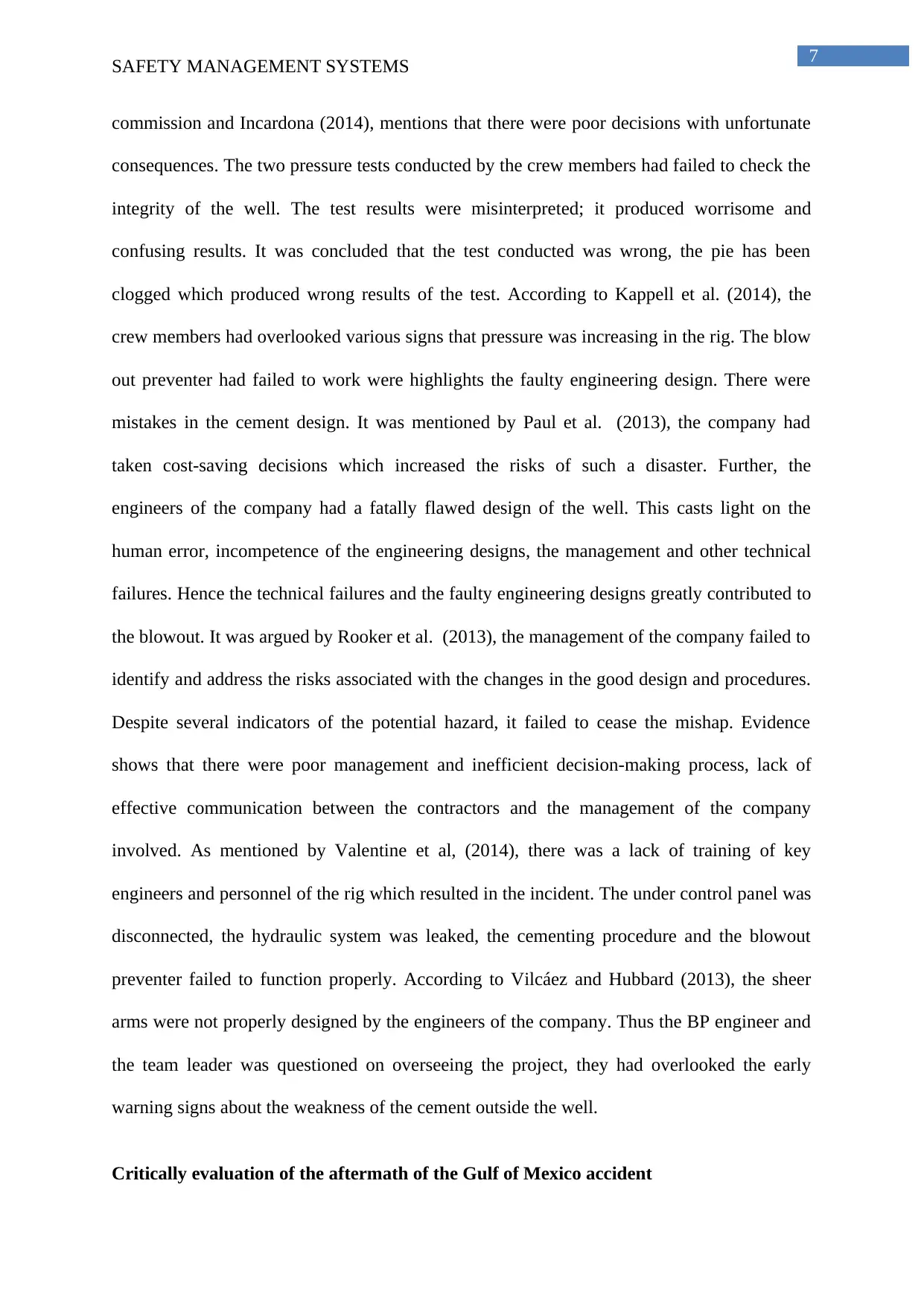
7
SAFETY MANAGEMENT SYSTEMS
commission and Incardona (2014), mentions that there were poor decisions with unfortunate
consequences. The two pressure tests conducted by the crew members had failed to check the
integrity of the well. The test results were misinterpreted; it produced worrisome and
confusing results. It was concluded that the test conducted was wrong, the pie has been
clogged which produced wrong results of the test. According to Kappell et al. (2014), the
crew members had overlooked various signs that pressure was increasing in the rig. The blow
out preventer had failed to work were highlights the faulty engineering design. There were
mistakes in the cement design. It was mentioned by Paul et al. (2013), the company had
taken cost-saving decisions which increased the risks of such a disaster. Further, the
engineers of the company had a fatally flawed design of the well. This casts light on the
human error, incompetence of the engineering designs, the management and other technical
failures. Hence the technical failures and the faulty engineering designs greatly contributed to
the blowout. It was argued by Rooker et al. (2013), the management of the company failed to
identify and address the risks associated with the changes in the good design and procedures.
Despite several indicators of the potential hazard, it failed to cease the mishap. Evidence
shows that there were poor management and inefficient decision-making process, lack of
effective communication between the contractors and the management of the company
involved. As mentioned by Valentine et al, (2014), there was a lack of training of key
engineers and personnel of the rig which resulted in the incident. The under control panel was
disconnected, the hydraulic system was leaked, the cementing procedure and the blowout
preventer failed to function properly. According to Vilcáez and Hubbard (2013), the sheer
arms were not properly designed by the engineers of the company. Thus the BP engineer and
the team leader was questioned on overseeing the project, they had overlooked the early
warning signs about the weakness of the cement outside the well.
Critically evaluation of the aftermath of the Gulf of Mexico accident
SAFETY MANAGEMENT SYSTEMS
commission and Incardona (2014), mentions that there were poor decisions with unfortunate
consequences. The two pressure tests conducted by the crew members had failed to check the
integrity of the well. The test results were misinterpreted; it produced worrisome and
confusing results. It was concluded that the test conducted was wrong, the pie has been
clogged which produced wrong results of the test. According to Kappell et al. (2014), the
crew members had overlooked various signs that pressure was increasing in the rig. The blow
out preventer had failed to work were highlights the faulty engineering design. There were
mistakes in the cement design. It was mentioned by Paul et al. (2013), the company had
taken cost-saving decisions which increased the risks of such a disaster. Further, the
engineers of the company had a fatally flawed design of the well. This casts light on the
human error, incompetence of the engineering designs, the management and other technical
failures. Hence the technical failures and the faulty engineering designs greatly contributed to
the blowout. It was argued by Rooker et al. (2013), the management of the company failed to
identify and address the risks associated with the changes in the good design and procedures.
Despite several indicators of the potential hazard, it failed to cease the mishap. Evidence
shows that there were poor management and inefficient decision-making process, lack of
effective communication between the contractors and the management of the company
involved. As mentioned by Valentine et al, (2014), there was a lack of training of key
engineers and personnel of the rig which resulted in the incident. The under control panel was
disconnected, the hydraulic system was leaked, the cementing procedure and the blowout
preventer failed to function properly. According to Vilcáez and Hubbard (2013), the sheer
arms were not properly designed by the engineers of the company. Thus the BP engineer and
the team leader was questioned on overseeing the project, they had overlooked the early
warning signs about the weakness of the cement outside the well.
Critically evaluation of the aftermath of the Gulf of Mexico accident
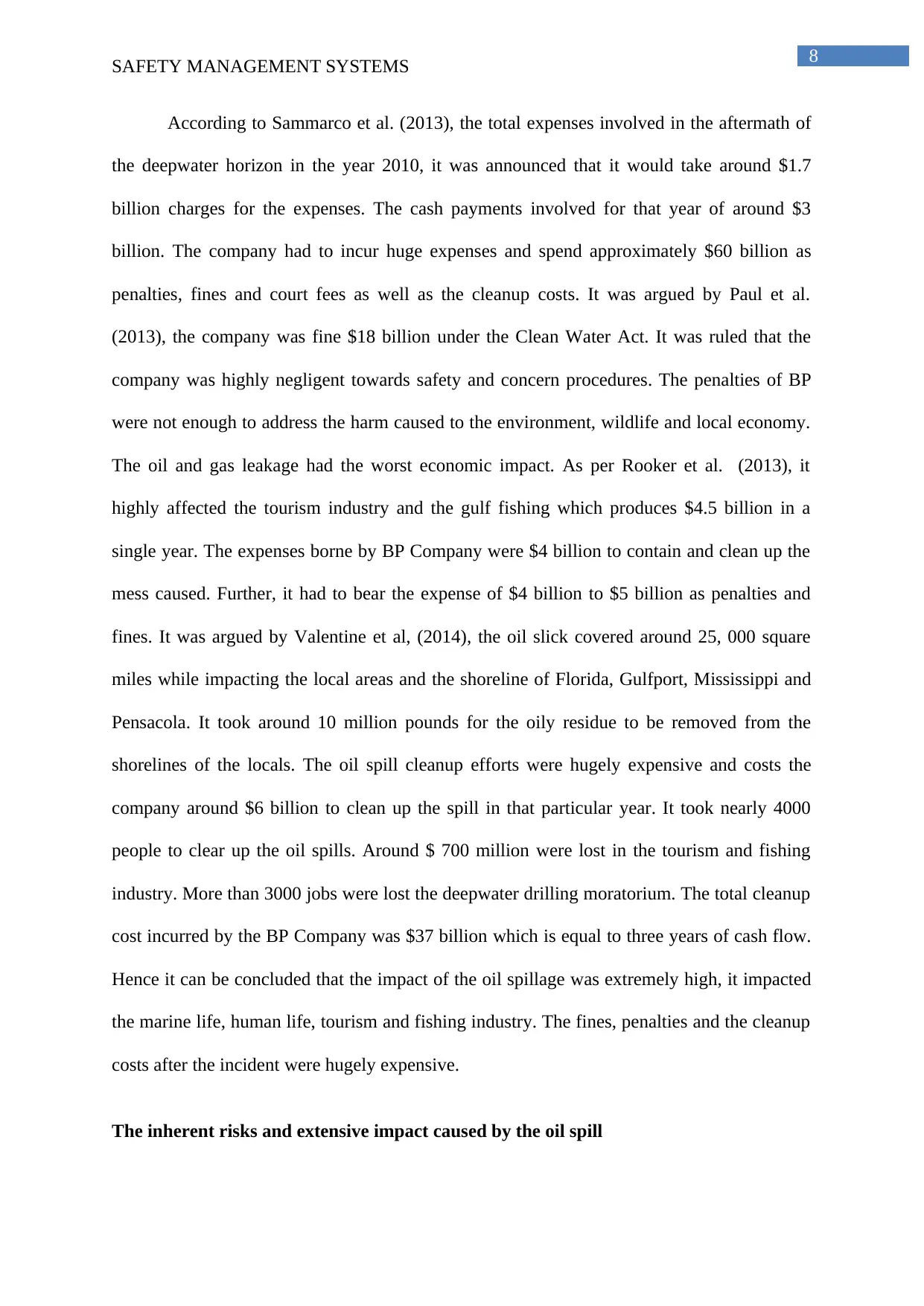
8
SAFETY MANAGEMENT SYSTEMS
According to Sammarco et al. (2013), the total expenses involved in the aftermath of
the deepwater horizon in the year 2010, it was announced that it would take around $1.7
billion charges for the expenses. The cash payments involved for that year of around $3
billion. The company had to incur huge expenses and spend approximately $60 billion as
penalties, fines and court fees as well as the cleanup costs. It was argued by Paul et al.
(2013), the company was fine $18 billion under the Clean Water Act. It was ruled that the
company was highly negligent towards safety and concern procedures. The penalties of BP
were not enough to address the harm caused to the environment, wildlife and local economy.
The oil and gas leakage had the worst economic impact. As per Rooker et al. (2013), it
highly affected the tourism industry and the gulf fishing which produces $4.5 billion in a
single year. The expenses borne by BP Company were $4 billion to contain and clean up the
mess caused. Further, it had to bear the expense of $4 billion to $5 billion as penalties and
fines. It was argued by Valentine et al, (2014), the oil slick covered around 25, 000 square
miles while impacting the local areas and the shoreline of Florida, Gulfport, Mississippi and
Pensacola. It took around 10 million pounds for the oily residue to be removed from the
shorelines of the locals. The oil spill cleanup efforts were hugely expensive and costs the
company around $6 billion to clean up the spill in that particular year. It took nearly 4000
people to clear up the oil spills. Around $ 700 million were lost in the tourism and fishing
industry. More than 3000 jobs were lost the deepwater drilling moratorium. The total cleanup
cost incurred by the BP Company was $37 billion which is equal to three years of cash flow.
Hence it can be concluded that the impact of the oil spillage was extremely high, it impacted
the marine life, human life, tourism and fishing industry. The fines, penalties and the cleanup
costs after the incident were hugely expensive.
The inherent risks and extensive impact caused by the oil spill
SAFETY MANAGEMENT SYSTEMS
According to Sammarco et al. (2013), the total expenses involved in the aftermath of
the deepwater horizon in the year 2010, it was announced that it would take around $1.7
billion charges for the expenses. The cash payments involved for that year of around $3
billion. The company had to incur huge expenses and spend approximately $60 billion as
penalties, fines and court fees as well as the cleanup costs. It was argued by Paul et al.
(2013), the company was fine $18 billion under the Clean Water Act. It was ruled that the
company was highly negligent towards safety and concern procedures. The penalties of BP
were not enough to address the harm caused to the environment, wildlife and local economy.
The oil and gas leakage had the worst economic impact. As per Rooker et al. (2013), it
highly affected the tourism industry and the gulf fishing which produces $4.5 billion in a
single year. The expenses borne by BP Company were $4 billion to contain and clean up the
mess caused. Further, it had to bear the expense of $4 billion to $5 billion as penalties and
fines. It was argued by Valentine et al, (2014), the oil slick covered around 25, 000 square
miles while impacting the local areas and the shoreline of Florida, Gulfport, Mississippi and
Pensacola. It took around 10 million pounds for the oily residue to be removed from the
shorelines of the locals. The oil spill cleanup efforts were hugely expensive and costs the
company around $6 billion to clean up the spill in that particular year. It took nearly 4000
people to clear up the oil spills. Around $ 700 million were lost in the tourism and fishing
industry. More than 3000 jobs were lost the deepwater drilling moratorium. The total cleanup
cost incurred by the BP Company was $37 billion which is equal to three years of cash flow.
Hence it can be concluded that the impact of the oil spillage was extremely high, it impacted
the marine life, human life, tourism and fishing industry. The fines, penalties and the cleanup
costs after the incident were hugely expensive.
The inherent risks and extensive impact caused by the oil spill
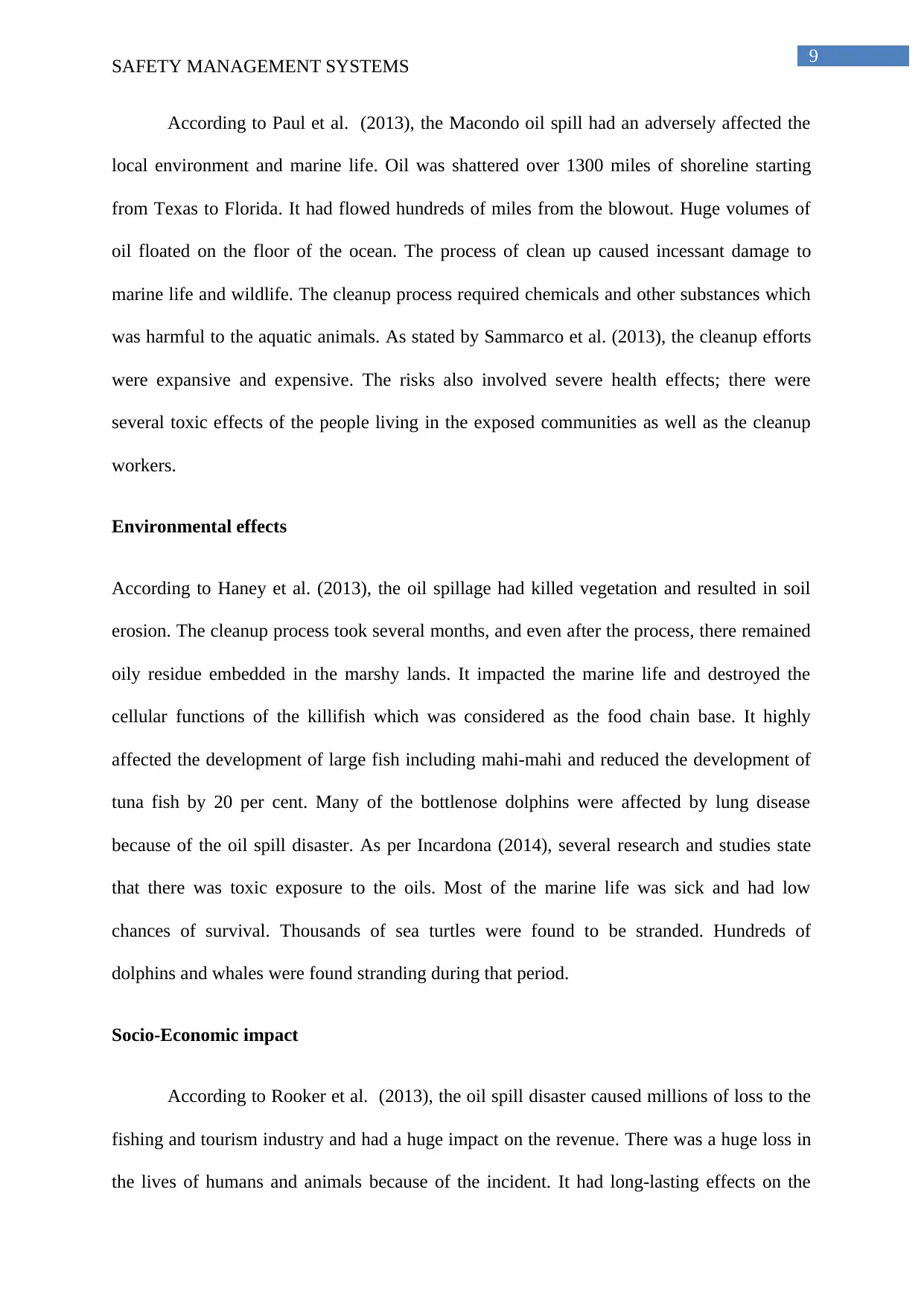
9
SAFETY MANAGEMENT SYSTEMS
According to Paul et al. (2013), the Macondo oil spill had an adversely affected the
local environment and marine life. Oil was shattered over 1300 miles of shoreline starting
from Texas to Florida. It had flowed hundreds of miles from the blowout. Huge volumes of
oil floated on the floor of the ocean. The process of clean up caused incessant damage to
marine life and wildlife. The cleanup process required chemicals and other substances which
was harmful to the aquatic animals. As stated by Sammarco et al. (2013), the cleanup efforts
were expansive and expensive. The risks also involved severe health effects; there were
several toxic effects of the people living in the exposed communities as well as the cleanup
workers.
Environmental effects
According to Haney et al. (2013), the oil spillage had killed vegetation and resulted in soil
erosion. The cleanup process took several months, and even after the process, there remained
oily residue embedded in the marshy lands. It impacted the marine life and destroyed the
cellular functions of the killifish which was considered as the food chain base. It highly
affected the development of large fish including mahi-mahi and reduced the development of
tuna fish by 20 per cent. Many of the bottlenose dolphins were affected by lung disease
because of the oil spill disaster. As per Incardona (2014), several research and studies state
that there was toxic exposure to the oils. Most of the marine life was sick and had low
chances of survival. Thousands of sea turtles were found to be stranded. Hundreds of
dolphins and whales were found stranding during that period.
Socio-Economic impact
According to Rooker et al. (2013), the oil spill disaster caused millions of loss to the
fishing and tourism industry and had a huge impact on the revenue. There was a huge loss in
the lives of humans and animals because of the incident. It had long-lasting effects on the
SAFETY MANAGEMENT SYSTEMS
According to Paul et al. (2013), the Macondo oil spill had an adversely affected the
local environment and marine life. Oil was shattered over 1300 miles of shoreline starting
from Texas to Florida. It had flowed hundreds of miles from the blowout. Huge volumes of
oil floated on the floor of the ocean. The process of clean up caused incessant damage to
marine life and wildlife. The cleanup process required chemicals and other substances which
was harmful to the aquatic animals. As stated by Sammarco et al. (2013), the cleanup efforts
were expansive and expensive. The risks also involved severe health effects; there were
several toxic effects of the people living in the exposed communities as well as the cleanup
workers.
Environmental effects
According to Haney et al. (2013), the oil spillage had killed vegetation and resulted in soil
erosion. The cleanup process took several months, and even after the process, there remained
oily residue embedded in the marshy lands. It impacted the marine life and destroyed the
cellular functions of the killifish which was considered as the food chain base. It highly
affected the development of large fish including mahi-mahi and reduced the development of
tuna fish by 20 per cent. Many of the bottlenose dolphins were affected by lung disease
because of the oil spill disaster. As per Incardona (2014), several research and studies state
that there was toxic exposure to the oils. Most of the marine life was sick and had low
chances of survival. Thousands of sea turtles were found to be stranded. Hundreds of
dolphins and whales were found stranding during that period.
Socio-Economic impact
According to Rooker et al. (2013), the oil spill disaster caused millions of loss to the
fishing and tourism industry and had a huge impact on the revenue. There was a huge loss in
the lives of humans and animals because of the incident. It had long-lasting effects on the
Secure Best Marks with AI Grader
Need help grading? Try our AI Grader for instant feedback on your assignments.
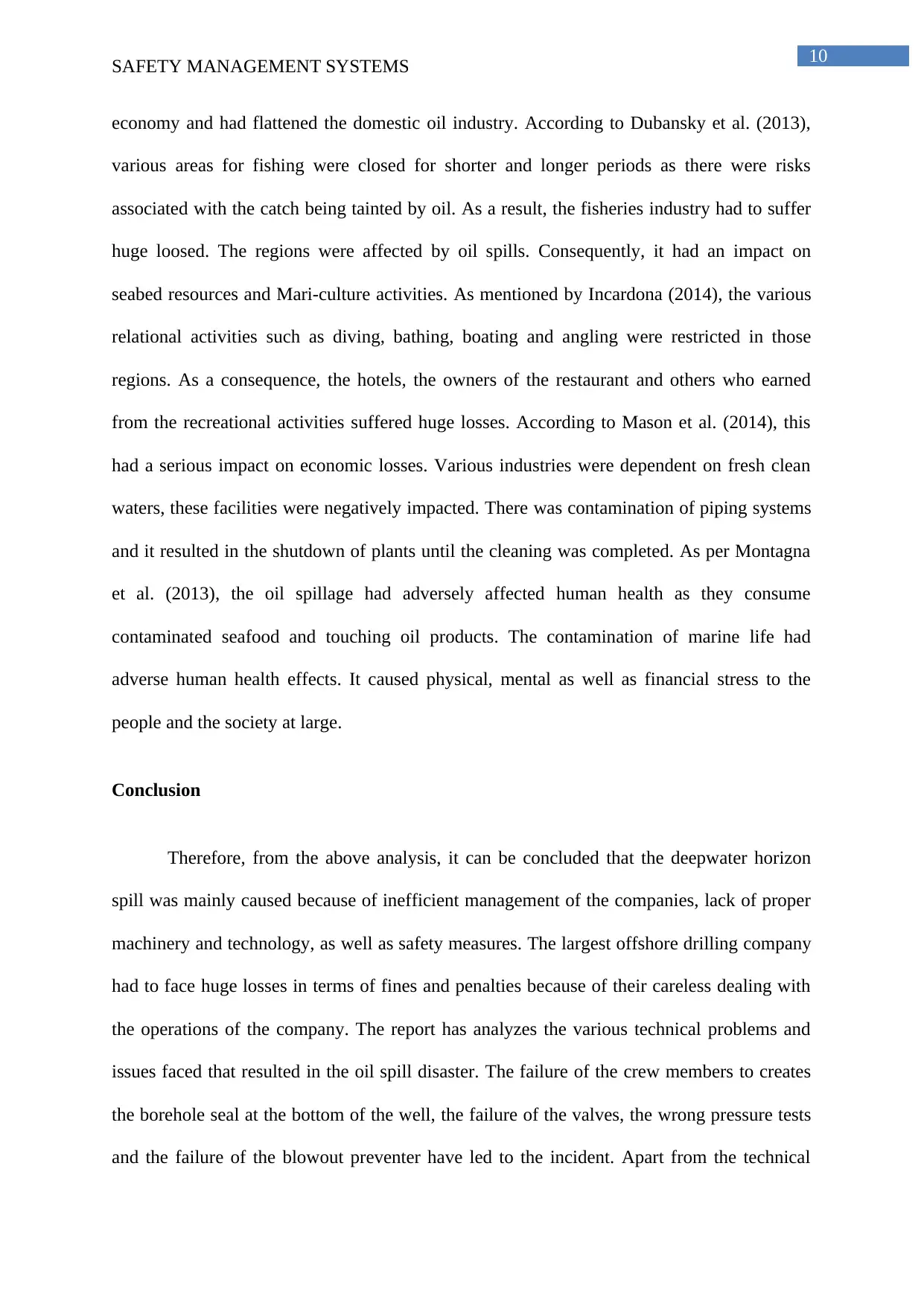
10
SAFETY MANAGEMENT SYSTEMS
economy and had flattened the domestic oil industry. According to Dubansky et al. (2013),
various areas for fishing were closed for shorter and longer periods as there were risks
associated with the catch being tainted by oil. As a result, the fisheries industry had to suffer
huge loosed. The regions were affected by oil spills. Consequently, it had an impact on
seabed resources and Mari-culture activities. As mentioned by Incardona (2014), the various
relational activities such as diving, bathing, boating and angling were restricted in those
regions. As a consequence, the hotels, the owners of the restaurant and others who earned
from the recreational activities suffered huge losses. According to Mason et al. (2014), this
had a serious impact on economic losses. Various industries were dependent on fresh clean
waters, these facilities were negatively impacted. There was contamination of piping systems
and it resulted in the shutdown of plants until the cleaning was completed. As per Montagna
et al. (2013), the oil spillage had adversely affected human health as they consume
contaminated seafood and touching oil products. The contamination of marine life had
adverse human health effects. It caused physical, mental as well as financial stress to the
people and the society at large.
Conclusion
Therefore, from the above analysis, it can be concluded that the deepwater horizon
spill was mainly caused because of inefficient management of the companies, lack of proper
machinery and technology, as well as safety measures. The largest offshore drilling company
had to face huge losses in terms of fines and penalties because of their careless dealing with
the operations of the company. The report has analyzes the various technical problems and
issues faced that resulted in the oil spill disaster. The failure of the crew members to creates
the borehole seal at the bottom of the well, the failure of the valves, the wrong pressure tests
and the failure of the blowout preventer have led to the incident. Apart from the technical
SAFETY MANAGEMENT SYSTEMS
economy and had flattened the domestic oil industry. According to Dubansky et al. (2013),
various areas for fishing were closed for shorter and longer periods as there were risks
associated with the catch being tainted by oil. As a result, the fisheries industry had to suffer
huge loosed. The regions were affected by oil spills. Consequently, it had an impact on
seabed resources and Mari-culture activities. As mentioned by Incardona (2014), the various
relational activities such as diving, bathing, boating and angling were restricted in those
regions. As a consequence, the hotels, the owners of the restaurant and others who earned
from the recreational activities suffered huge losses. According to Mason et al. (2014), this
had a serious impact on economic losses. Various industries were dependent on fresh clean
waters, these facilities were negatively impacted. There was contamination of piping systems
and it resulted in the shutdown of plants until the cleaning was completed. As per Montagna
et al. (2013), the oil spillage had adversely affected human health as they consume
contaminated seafood and touching oil products. The contamination of marine life had
adverse human health effects. It caused physical, mental as well as financial stress to the
people and the society at large.
Conclusion
Therefore, from the above analysis, it can be concluded that the deepwater horizon
spill was mainly caused because of inefficient management of the companies, lack of proper
machinery and technology, as well as safety measures. The largest offshore drilling company
had to face huge losses in terms of fines and penalties because of their careless dealing with
the operations of the company. The report has analyzes the various technical problems and
issues faced that resulted in the oil spill disaster. The failure of the crew members to creates
the borehole seal at the bottom of the well, the failure of the valves, the wrong pressure tests
and the failure of the blowout preventer have led to the incident. Apart from the technical
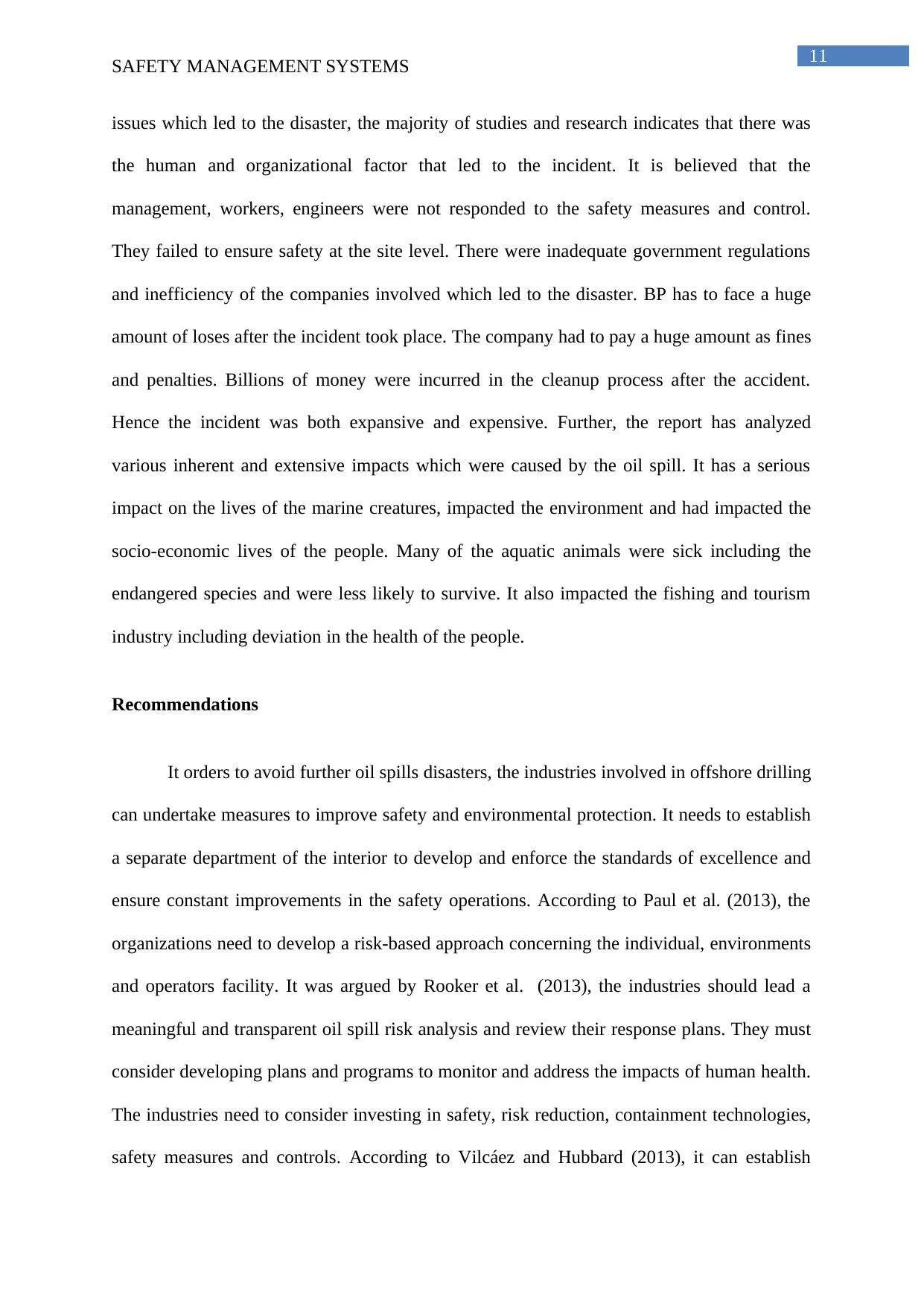
11
SAFETY MANAGEMENT SYSTEMS
issues which led to the disaster, the majority of studies and research indicates that there was
the human and organizational factor that led to the incident. It is believed that the
management, workers, engineers were not responded to the safety measures and control.
They failed to ensure safety at the site level. There were inadequate government regulations
and inefficiency of the companies involved which led to the disaster. BP has to face a huge
amount of loses after the incident took place. The company had to pay a huge amount as fines
and penalties. Billions of money were incurred in the cleanup process after the accident.
Hence the incident was both expansive and expensive. Further, the report has analyzed
various inherent and extensive impacts which were caused by the oil spill. It has a serious
impact on the lives of the marine creatures, impacted the environment and had impacted the
socio-economic lives of the people. Many of the aquatic animals were sick including the
endangered species and were less likely to survive. It also impacted the fishing and tourism
industry including deviation in the health of the people.
Recommendations
It orders to avoid further oil spills disasters, the industries involved in offshore drilling
can undertake measures to improve safety and environmental protection. It needs to establish
a separate department of the interior to develop and enforce the standards of excellence and
ensure constant improvements in the safety operations. According to Paul et al. (2013), the
organizations need to develop a risk-based approach concerning the individual, environments
and operators facility. It was argued by Rooker et al. (2013), the industries should lead a
meaningful and transparent oil spill risk analysis and review their response plans. They must
consider developing plans and programs to monitor and address the impacts of human health.
The industries need to consider investing in safety, risk reduction, containment technologies,
safety measures and controls. According to Vilcáez and Hubbard (2013), it can establish
SAFETY MANAGEMENT SYSTEMS
issues which led to the disaster, the majority of studies and research indicates that there was
the human and organizational factor that led to the incident. It is believed that the
management, workers, engineers were not responded to the safety measures and control.
They failed to ensure safety at the site level. There were inadequate government regulations
and inefficiency of the companies involved which led to the disaster. BP has to face a huge
amount of loses after the incident took place. The company had to pay a huge amount as fines
and penalties. Billions of money were incurred in the cleanup process after the accident.
Hence the incident was both expansive and expensive. Further, the report has analyzed
various inherent and extensive impacts which were caused by the oil spill. It has a serious
impact on the lives of the marine creatures, impacted the environment and had impacted the
socio-economic lives of the people. Many of the aquatic animals were sick including the
endangered species and were less likely to survive. It also impacted the fishing and tourism
industry including deviation in the health of the people.
Recommendations
It orders to avoid further oil spills disasters, the industries involved in offshore drilling
can undertake measures to improve safety and environmental protection. It needs to establish
a separate department of the interior to develop and enforce the standards of excellence and
ensure constant improvements in the safety operations. According to Paul et al. (2013), the
organizations need to develop a risk-based approach concerning the individual, environments
and operators facility. It was argued by Rooker et al. (2013), the industries should lead a
meaningful and transparent oil spill risk analysis and review their response plans. They must
consider developing plans and programs to monitor and address the impacts of human health.
The industries need to consider investing in safety, risk reduction, containment technologies,
safety measures and controls. According to Vilcáez and Hubbard (2013), it can establish
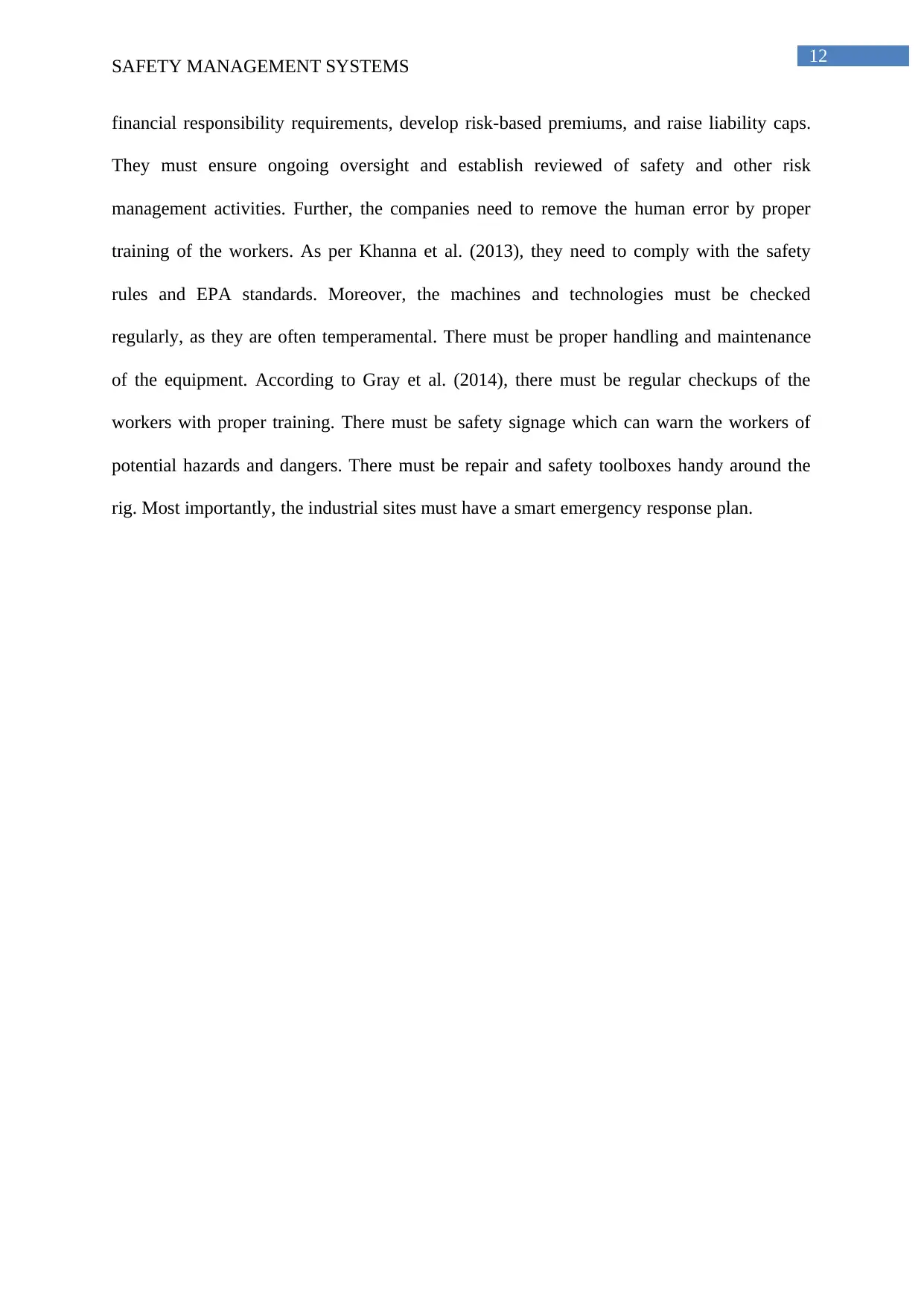
12
SAFETY MANAGEMENT SYSTEMS
financial responsibility requirements, develop risk-based premiums, and raise liability caps.
They must ensure ongoing oversight and establish reviewed of safety and other risk
management activities. Further, the companies need to remove the human error by proper
training of the workers. As per Khanna et al. (2013), they need to comply with the safety
rules and EPA standards. Moreover, the machines and technologies must be checked
regularly, as they are often temperamental. There must be proper handling and maintenance
of the equipment. According to Gray et al. (2014), there must be regular checkups of the
workers with proper training. There must be safety signage which can warn the workers of
potential hazards and dangers. There must be repair and safety toolboxes handy around the
rig. Most importantly, the industrial sites must have a smart emergency response plan.
SAFETY MANAGEMENT SYSTEMS
financial responsibility requirements, develop risk-based premiums, and raise liability caps.
They must ensure ongoing oversight and establish reviewed of safety and other risk
management activities. Further, the companies need to remove the human error by proper
training of the workers. As per Khanna et al. (2013), they need to comply with the safety
rules and EPA standards. Moreover, the machines and technologies must be checked
regularly, as they are often temperamental. There must be proper handling and maintenance
of the equipment. According to Gray et al. (2014), there must be regular checkups of the
workers with proper training. There must be safety signage which can warn the workers of
potential hazards and dangers. There must be repair and safety toolboxes handy around the
rig. Most importantly, the industrial sites must have a smart emergency response plan.
Paraphrase This Document
Need a fresh take? Get an instant paraphrase of this document with our AI Paraphraser
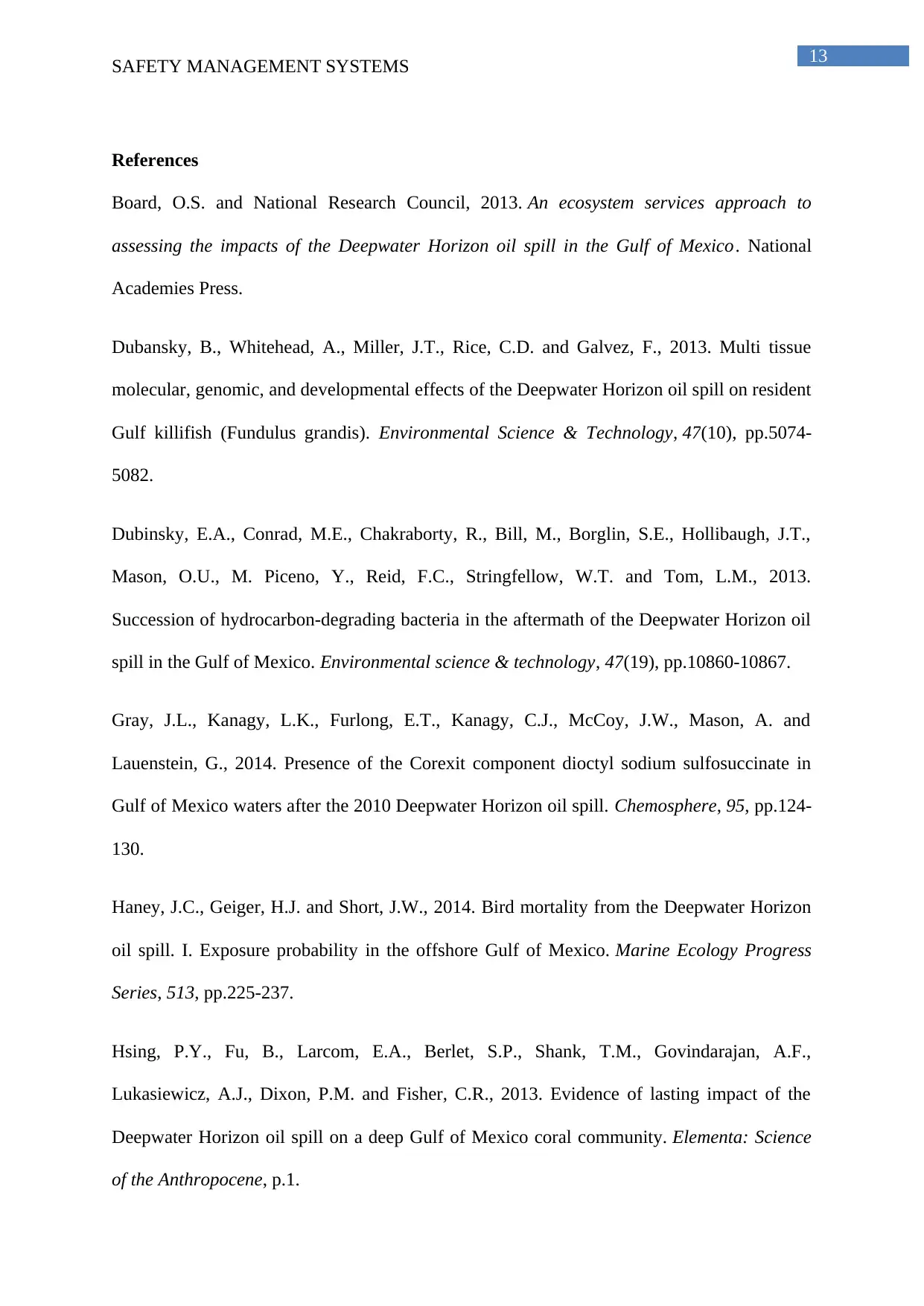
13
SAFETY MANAGEMENT SYSTEMS
References
Board, O.S. and National Research Council, 2013. An ecosystem services approach to
assessing the impacts of the Deepwater Horizon oil spill in the Gulf of Mexico. National
Academies Press.
Dubansky, B., Whitehead, A., Miller, J.T., Rice, C.D. and Galvez, F., 2013. Multi tissue
molecular, genomic, and developmental effects of the Deepwater Horizon oil spill on resident
Gulf killifish (Fundulus grandis). Environmental Science & Technology, 47(10), pp.5074-
5082.
Dubinsky, E.A., Conrad, M.E., Chakraborty, R., Bill, M., Borglin, S.E., Hollibaugh, J.T.,
Mason, O.U., M. Piceno, Y., Reid, F.C., Stringfellow, W.T. and Tom, L.M., 2013.
Succession of hydrocarbon-degrading bacteria in the aftermath of the Deepwater Horizon oil
spill in the Gulf of Mexico. Environmental science & technology, 47(19), pp.10860-10867.
Gray, J.L., Kanagy, L.K., Furlong, E.T., Kanagy, C.J., McCoy, J.W., Mason, A. and
Lauenstein, G., 2014. Presence of the Corexit component dioctyl sodium sulfosuccinate in
Gulf of Mexico waters after the 2010 Deepwater Horizon oil spill. Chemosphere, 95, pp.124-
130.
Haney, J.C., Geiger, H.J. and Short, J.W., 2014. Bird mortality from the Deepwater Horizon
oil spill. I. Exposure probability in the offshore Gulf of Mexico. Marine Ecology Progress
Series, 513, pp.225-237.
Hsing, P.Y., Fu, B., Larcom, E.A., Berlet, S.P., Shank, T.M., Govindarajan, A.F.,
Lukasiewicz, A.J., Dixon, P.M. and Fisher, C.R., 2013. Evidence of lasting impact of the
Deepwater Horizon oil spill on a deep Gulf of Mexico coral community. Elementa: Science
of the Anthropocene, p.1.
SAFETY MANAGEMENT SYSTEMS
References
Board, O.S. and National Research Council, 2013. An ecosystem services approach to
assessing the impacts of the Deepwater Horizon oil spill in the Gulf of Mexico. National
Academies Press.
Dubansky, B., Whitehead, A., Miller, J.T., Rice, C.D. and Galvez, F., 2013. Multi tissue
molecular, genomic, and developmental effects of the Deepwater Horizon oil spill on resident
Gulf killifish (Fundulus grandis). Environmental Science & Technology, 47(10), pp.5074-
5082.
Dubinsky, E.A., Conrad, M.E., Chakraborty, R., Bill, M., Borglin, S.E., Hollibaugh, J.T.,
Mason, O.U., M. Piceno, Y., Reid, F.C., Stringfellow, W.T. and Tom, L.M., 2013.
Succession of hydrocarbon-degrading bacteria in the aftermath of the Deepwater Horizon oil
spill in the Gulf of Mexico. Environmental science & technology, 47(19), pp.10860-10867.
Gray, J.L., Kanagy, L.K., Furlong, E.T., Kanagy, C.J., McCoy, J.W., Mason, A. and
Lauenstein, G., 2014. Presence of the Corexit component dioctyl sodium sulfosuccinate in
Gulf of Mexico waters after the 2010 Deepwater Horizon oil spill. Chemosphere, 95, pp.124-
130.
Haney, J.C., Geiger, H.J. and Short, J.W., 2014. Bird mortality from the Deepwater Horizon
oil spill. I. Exposure probability in the offshore Gulf of Mexico. Marine Ecology Progress
Series, 513, pp.225-237.
Hsing, P.Y., Fu, B., Larcom, E.A., Berlet, S.P., Shank, T.M., Govindarajan, A.F.,
Lukasiewicz, A.J., Dixon, P.M. and Fisher, C.R., 2013. Evidence of lasting impact of the
Deepwater Horizon oil spill on a deep Gulf of Mexico coral community. Elementa: Science
of the Anthropocene, p.1.
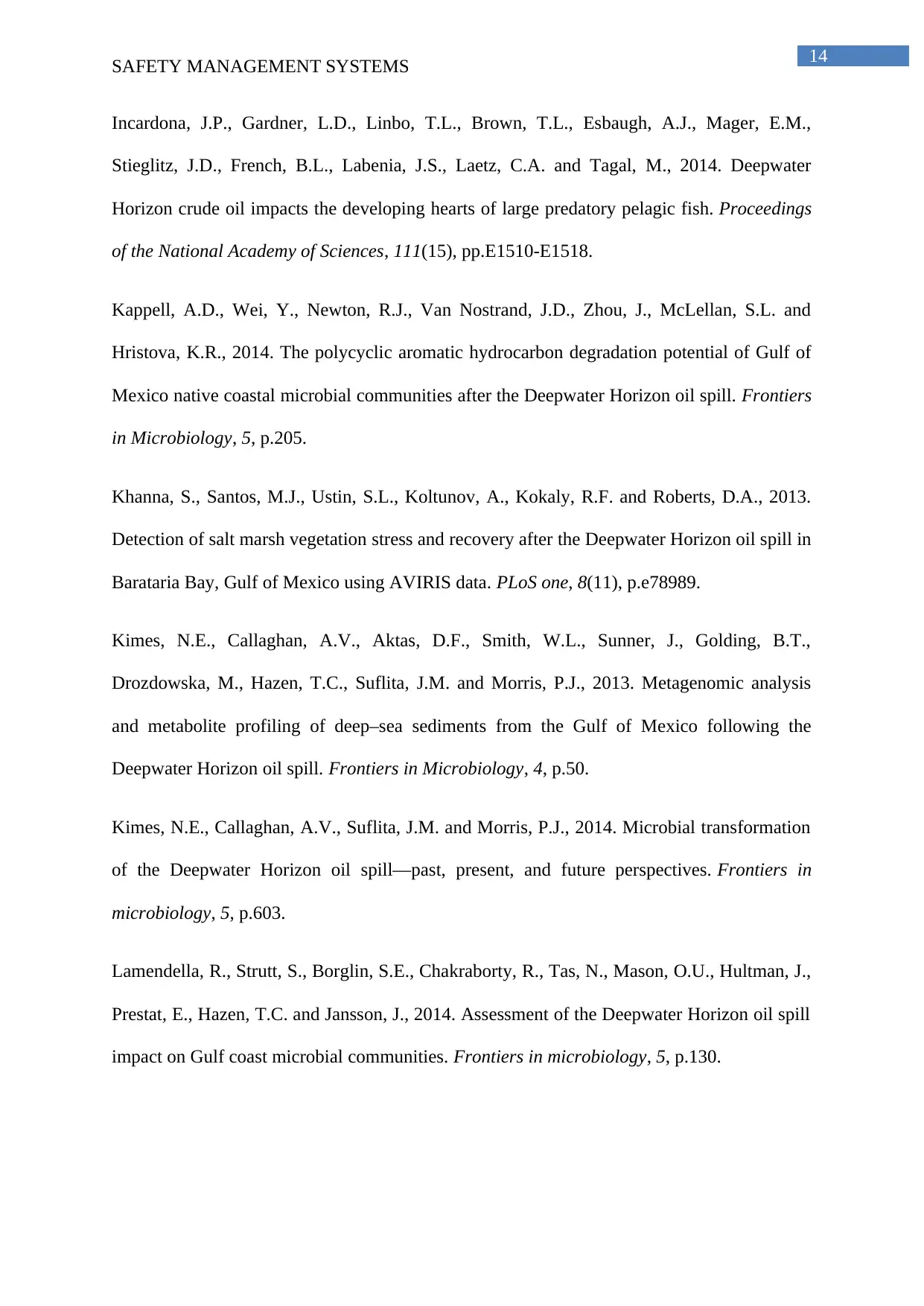
14
SAFETY MANAGEMENT SYSTEMS
Incardona, J.P., Gardner, L.D., Linbo, T.L., Brown, T.L., Esbaugh, A.J., Mager, E.M.,
Stieglitz, J.D., French, B.L., Labenia, J.S., Laetz, C.A. and Tagal, M., 2014. Deepwater
Horizon crude oil impacts the developing hearts of large predatory pelagic fish. Proceedings
of the National Academy of Sciences, 111(15), pp.E1510-E1518.
Kappell, A.D., Wei, Y., Newton, R.J., Van Nostrand, J.D., Zhou, J., McLellan, S.L. and
Hristova, K.R., 2014. The polycyclic aromatic hydrocarbon degradation potential of Gulf of
Mexico native coastal microbial communities after the Deepwater Horizon oil spill. Frontiers
in Microbiology, 5, p.205.
Khanna, S., Santos, M.J., Ustin, S.L., Koltunov, A., Kokaly, R.F. and Roberts, D.A., 2013.
Detection of salt marsh vegetation stress and recovery after the Deepwater Horizon oil spill in
Barataria Bay, Gulf of Mexico using AVIRIS data. PLoS one, 8(11), p.e78989.
Kimes, N.E., Callaghan, A.V., Aktas, D.F., Smith, W.L., Sunner, J., Golding, B.T.,
Drozdowska, M., Hazen, T.C., Suflita, J.M. and Morris, P.J., 2013. Metagenomic analysis
and metabolite profiling of deep–sea sediments from the Gulf of Mexico following the
Deepwater Horizon oil spill. Frontiers in Microbiology, 4, p.50.
Kimes, N.E., Callaghan, A.V., Suflita, J.M. and Morris, P.J., 2014. Microbial transformation
of the Deepwater Horizon oil spill—past, present, and future perspectives. Frontiers in
microbiology, 5, p.603.
Lamendella, R., Strutt, S., Borglin, S.E., Chakraborty, R., Tas, N., Mason, O.U., Hultman, J.,
Prestat, E., Hazen, T.C. and Jansson, J., 2014. Assessment of the Deepwater Horizon oil spill
impact on Gulf coast microbial communities. Frontiers in microbiology, 5, p.130.
SAFETY MANAGEMENT SYSTEMS
Incardona, J.P., Gardner, L.D., Linbo, T.L., Brown, T.L., Esbaugh, A.J., Mager, E.M.,
Stieglitz, J.D., French, B.L., Labenia, J.S., Laetz, C.A. and Tagal, M., 2014. Deepwater
Horizon crude oil impacts the developing hearts of large predatory pelagic fish. Proceedings
of the National Academy of Sciences, 111(15), pp.E1510-E1518.
Kappell, A.D., Wei, Y., Newton, R.J., Van Nostrand, J.D., Zhou, J., McLellan, S.L. and
Hristova, K.R., 2014. The polycyclic aromatic hydrocarbon degradation potential of Gulf of
Mexico native coastal microbial communities after the Deepwater Horizon oil spill. Frontiers
in Microbiology, 5, p.205.
Khanna, S., Santos, M.J., Ustin, S.L., Koltunov, A., Kokaly, R.F. and Roberts, D.A., 2013.
Detection of salt marsh vegetation stress and recovery after the Deepwater Horizon oil spill in
Barataria Bay, Gulf of Mexico using AVIRIS data. PLoS one, 8(11), p.e78989.
Kimes, N.E., Callaghan, A.V., Aktas, D.F., Smith, W.L., Sunner, J., Golding, B.T.,
Drozdowska, M., Hazen, T.C., Suflita, J.M. and Morris, P.J., 2013. Metagenomic analysis
and metabolite profiling of deep–sea sediments from the Gulf of Mexico following the
Deepwater Horizon oil spill. Frontiers in Microbiology, 4, p.50.
Kimes, N.E., Callaghan, A.V., Suflita, J.M. and Morris, P.J., 2014. Microbial transformation
of the Deepwater Horizon oil spill—past, present, and future perspectives. Frontiers in
microbiology, 5, p.603.
Lamendella, R., Strutt, S., Borglin, S.E., Chakraborty, R., Tas, N., Mason, O.U., Hultman, J.,
Prestat, E., Hazen, T.C. and Jansson, J., 2014. Assessment of the Deepwater Horizon oil spill
impact on Gulf coast microbial communities. Frontiers in microbiology, 5, p.130.
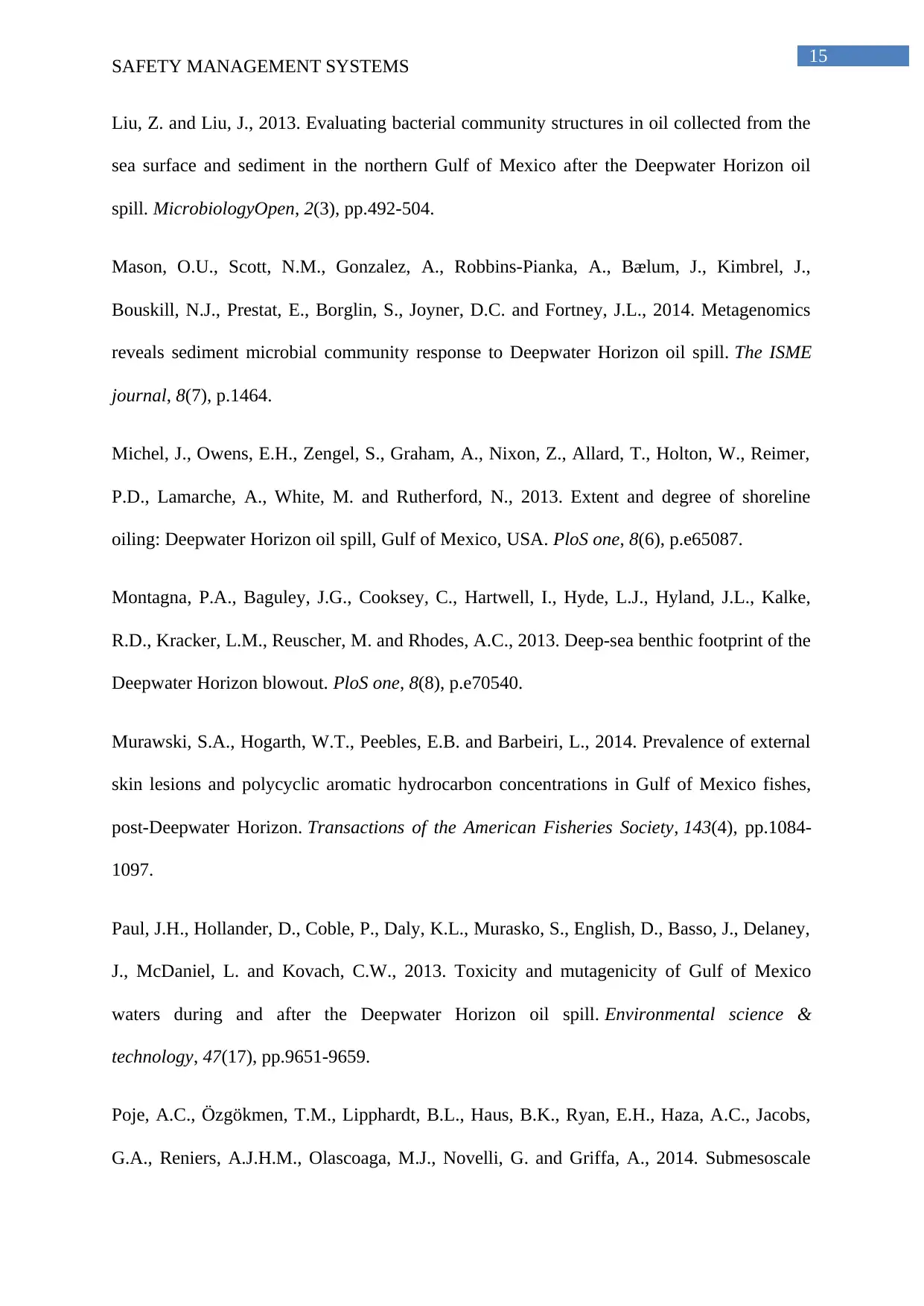
15
SAFETY MANAGEMENT SYSTEMS
Liu, Z. and Liu, J., 2013. Evaluating bacterial community structures in oil collected from the
sea surface and sediment in the northern Gulf of Mexico after the Deepwater Horizon oil
spill. MicrobiologyOpen, 2(3), pp.492-504.
Mason, O.U., Scott, N.M., Gonzalez, A., Robbins-Pianka, A., Bælum, J., Kimbrel, J.,
Bouskill, N.J., Prestat, E., Borglin, S., Joyner, D.C. and Fortney, J.L., 2014. Metagenomics
reveals sediment microbial community response to Deepwater Horizon oil spill. The ISME
journal, 8(7), p.1464.
Michel, J., Owens, E.H., Zengel, S., Graham, A., Nixon, Z., Allard, T., Holton, W., Reimer,
P.D., Lamarche, A., White, M. and Rutherford, N., 2013. Extent and degree of shoreline
oiling: Deepwater Horizon oil spill, Gulf of Mexico, USA. PloS one, 8(6), p.e65087.
Montagna, P.A., Baguley, J.G., Cooksey, C., Hartwell, I., Hyde, L.J., Hyland, J.L., Kalke,
R.D., Kracker, L.M., Reuscher, M. and Rhodes, A.C., 2013. Deep-sea benthic footprint of the
Deepwater Horizon blowout. PloS one, 8(8), p.e70540.
Murawski, S.A., Hogarth, W.T., Peebles, E.B. and Barbeiri, L., 2014. Prevalence of external
skin lesions and polycyclic aromatic hydrocarbon concentrations in Gulf of Mexico fishes,
post-Deepwater Horizon. Transactions of the American Fisheries Society, 143(4), pp.1084-
1097.
Paul, J.H., Hollander, D., Coble, P., Daly, K.L., Murasko, S., English, D., Basso, J., Delaney,
J., McDaniel, L. and Kovach, C.W., 2013. Toxicity and mutagenicity of Gulf of Mexico
waters during and after the Deepwater Horizon oil spill. Environmental science &
technology, 47(17), pp.9651-9659.
Poje, A.C., Özgökmen, T.M., Lipphardt, B.L., Haus, B.K., Ryan, E.H., Haza, A.C., Jacobs,
G.A., Reniers, A.J.H.M., Olascoaga, M.J., Novelli, G. and Griffa, A., 2014. Submesoscale
SAFETY MANAGEMENT SYSTEMS
Liu, Z. and Liu, J., 2013. Evaluating bacterial community structures in oil collected from the
sea surface and sediment in the northern Gulf of Mexico after the Deepwater Horizon oil
spill. MicrobiologyOpen, 2(3), pp.492-504.
Mason, O.U., Scott, N.M., Gonzalez, A., Robbins-Pianka, A., Bælum, J., Kimbrel, J.,
Bouskill, N.J., Prestat, E., Borglin, S., Joyner, D.C. and Fortney, J.L., 2014. Metagenomics
reveals sediment microbial community response to Deepwater Horizon oil spill. The ISME
journal, 8(7), p.1464.
Michel, J., Owens, E.H., Zengel, S., Graham, A., Nixon, Z., Allard, T., Holton, W., Reimer,
P.D., Lamarche, A., White, M. and Rutherford, N., 2013. Extent and degree of shoreline
oiling: Deepwater Horizon oil spill, Gulf of Mexico, USA. PloS one, 8(6), p.e65087.
Montagna, P.A., Baguley, J.G., Cooksey, C., Hartwell, I., Hyde, L.J., Hyland, J.L., Kalke,
R.D., Kracker, L.M., Reuscher, M. and Rhodes, A.C., 2013. Deep-sea benthic footprint of the
Deepwater Horizon blowout. PloS one, 8(8), p.e70540.
Murawski, S.A., Hogarth, W.T., Peebles, E.B. and Barbeiri, L., 2014. Prevalence of external
skin lesions and polycyclic aromatic hydrocarbon concentrations in Gulf of Mexico fishes,
post-Deepwater Horizon. Transactions of the American Fisheries Society, 143(4), pp.1084-
1097.
Paul, J.H., Hollander, D., Coble, P., Daly, K.L., Murasko, S., English, D., Basso, J., Delaney,
J., McDaniel, L. and Kovach, C.W., 2013. Toxicity and mutagenicity of Gulf of Mexico
waters during and after the Deepwater Horizon oil spill. Environmental science &
technology, 47(17), pp.9651-9659.
Poje, A.C., Özgökmen, T.M., Lipphardt, B.L., Haus, B.K., Ryan, E.H., Haza, A.C., Jacobs,
G.A., Reniers, A.J.H.M., Olascoaga, M.J., Novelli, G. and Griffa, A., 2014. Submesoscale
Secure Best Marks with AI Grader
Need help grading? Try our AI Grader for instant feedback on your assignments.
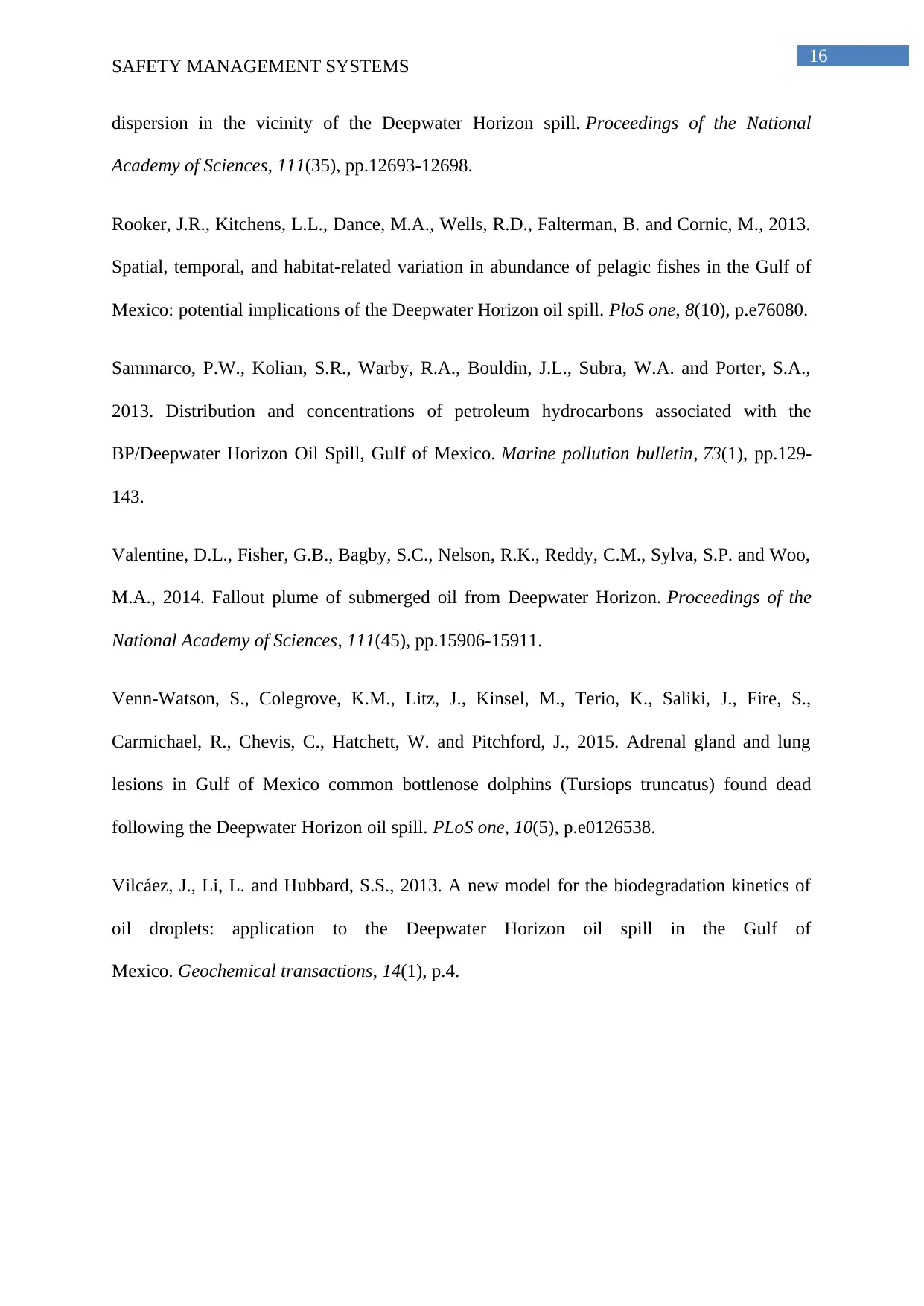
16
SAFETY MANAGEMENT SYSTEMS
dispersion in the vicinity of the Deepwater Horizon spill. Proceedings of the National
Academy of Sciences, 111(35), pp.12693-12698.
Rooker, J.R., Kitchens, L.L., Dance, M.A., Wells, R.D., Falterman, B. and Cornic, M., 2013.
Spatial, temporal, and habitat-related variation in abundance of pelagic fishes in the Gulf of
Mexico: potential implications of the Deepwater Horizon oil spill. PloS one, 8(10), p.e76080.
Sammarco, P.W., Kolian, S.R., Warby, R.A., Bouldin, J.L., Subra, W.A. and Porter, S.A.,
2013. Distribution and concentrations of petroleum hydrocarbons associated with the
BP/Deepwater Horizon Oil Spill, Gulf of Mexico. Marine pollution bulletin, 73(1), pp.129-
143.
Valentine, D.L., Fisher, G.B., Bagby, S.C., Nelson, R.K., Reddy, C.M., Sylva, S.P. and Woo,
M.A., 2014. Fallout plume of submerged oil from Deepwater Horizon. Proceedings of the
National Academy of Sciences, 111(45), pp.15906-15911.
Venn-Watson, S., Colegrove, K.M., Litz, J., Kinsel, M., Terio, K., Saliki, J., Fire, S.,
Carmichael, R., Chevis, C., Hatchett, W. and Pitchford, J., 2015. Adrenal gland and lung
lesions in Gulf of Mexico common bottlenose dolphins (Tursiops truncatus) found dead
following the Deepwater Horizon oil spill. PLoS one, 10(5), p.e0126538.
Vilcáez, J., Li, L. and Hubbard, S.S., 2013. A new model for the biodegradation kinetics of
oil droplets: application to the Deepwater Horizon oil spill in the Gulf of
Mexico. Geochemical transactions, 14(1), p.4.
SAFETY MANAGEMENT SYSTEMS
dispersion in the vicinity of the Deepwater Horizon spill. Proceedings of the National
Academy of Sciences, 111(35), pp.12693-12698.
Rooker, J.R., Kitchens, L.L., Dance, M.A., Wells, R.D., Falterman, B. and Cornic, M., 2013.
Spatial, temporal, and habitat-related variation in abundance of pelagic fishes in the Gulf of
Mexico: potential implications of the Deepwater Horizon oil spill. PloS one, 8(10), p.e76080.
Sammarco, P.W., Kolian, S.R., Warby, R.A., Bouldin, J.L., Subra, W.A. and Porter, S.A.,
2013. Distribution and concentrations of petroleum hydrocarbons associated with the
BP/Deepwater Horizon Oil Spill, Gulf of Mexico. Marine pollution bulletin, 73(1), pp.129-
143.
Valentine, D.L., Fisher, G.B., Bagby, S.C., Nelson, R.K., Reddy, C.M., Sylva, S.P. and Woo,
M.A., 2014. Fallout plume of submerged oil from Deepwater Horizon. Proceedings of the
National Academy of Sciences, 111(45), pp.15906-15911.
Venn-Watson, S., Colegrove, K.M., Litz, J., Kinsel, M., Terio, K., Saliki, J., Fire, S.,
Carmichael, R., Chevis, C., Hatchett, W. and Pitchford, J., 2015. Adrenal gland and lung
lesions in Gulf of Mexico common bottlenose dolphins (Tursiops truncatus) found dead
following the Deepwater Horizon oil spill. PLoS one, 10(5), p.e0126538.
Vilcáez, J., Li, L. and Hubbard, S.S., 2013. A new model for the biodegradation kinetics of
oil droplets: application to the Deepwater Horizon oil spill in the Gulf of
Mexico. Geochemical transactions, 14(1), p.4.
1 out of 17
Related Documents
Your All-in-One AI-Powered Toolkit for Academic Success.
+13062052269
info@desklib.com
Available 24*7 on WhatsApp / Email
![[object Object]](/_next/static/media/star-bottom.7253800d.svg)
Unlock your academic potential
© 2024 | Zucol Services PVT LTD | All rights reserved.





